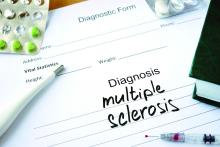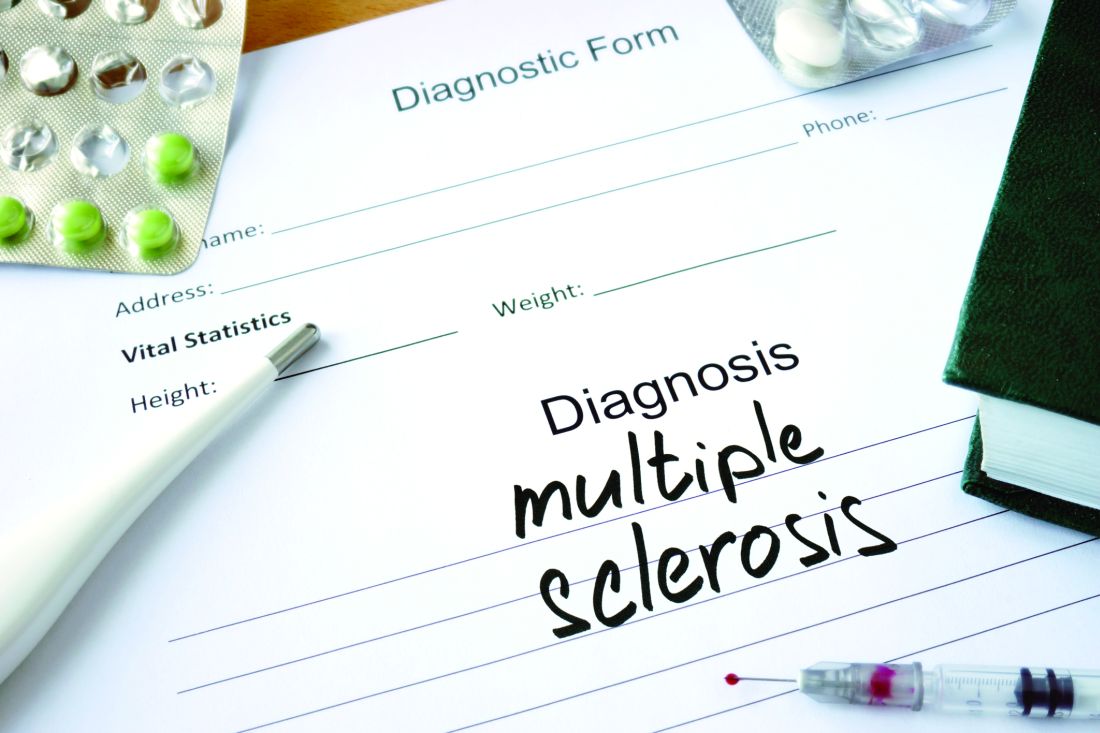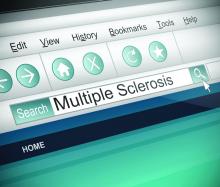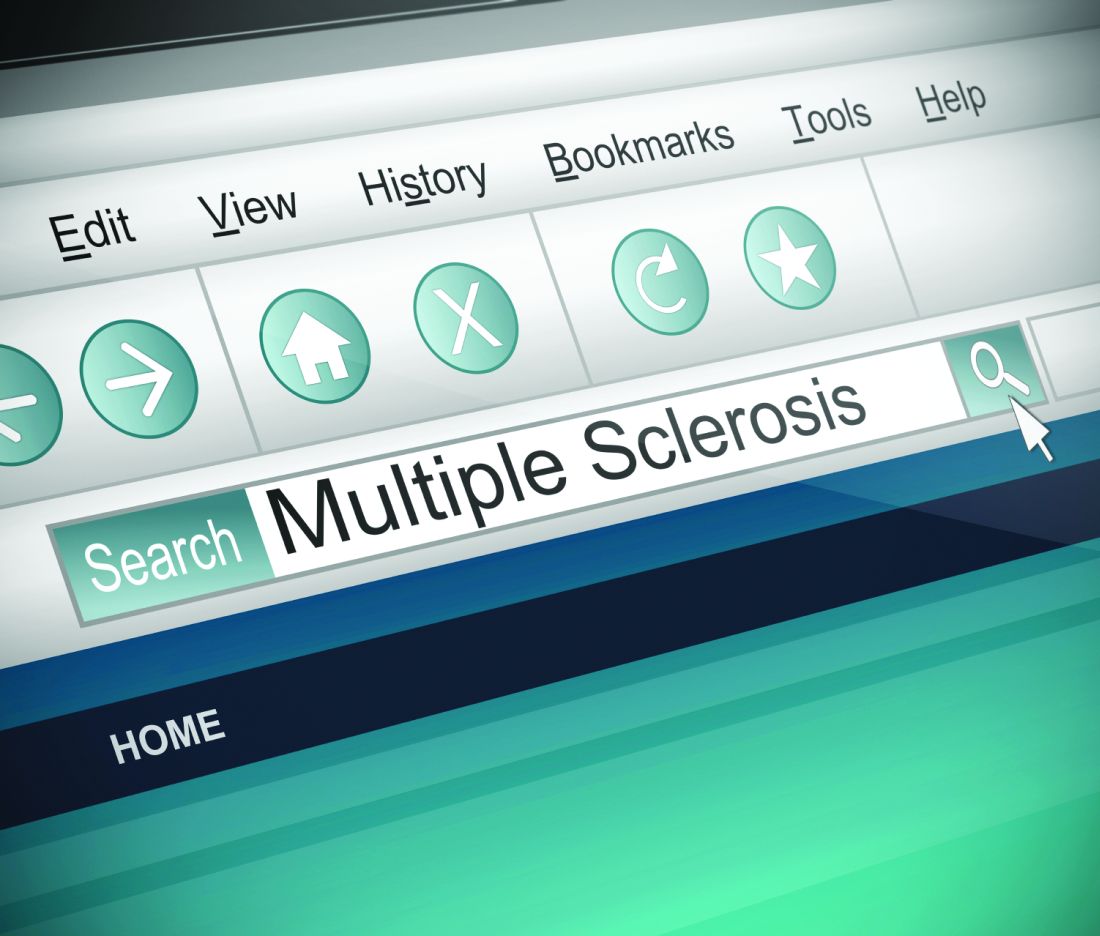User login
Multiple Sclerosis Hub
Nomogram predicts conversion of first demyelinating event to definite MS
Baseline and follow-up data from a prospective, multinational cohort of more than 3,000 patients with clinically isolated events allowed researchers to develop an accurate prognostic nomogram to calculate an individual’s risk for conversion to clinically definite multiple sclerosis at 12 months.
“Identification of patient, disease, and examination factors associated with higher probability of second attack in clinical practice may enable clinicians to flag patients that could benefit from more intensive follow-up and consideration of early DMD [disease-modifying drug] treatment intervention, facilitating more favorable patient outcomes,” wrote Tim Spelman, PhD, and his associates.
Risk of relapse was decreased when clinically isolated syndrome was diagnosed later, with an adjusted hazard ratio of 0.9 for every 5 additional years of age. Other risk factors for earlier relapse include higher Expanded Disability Status Scale score at the onset of the first demyelinating event, DMD exposure prior to the first attack, multiple brain and spinal MRI criteria, and oligoclonal bands.
“These results corroborate and extend prior, albeit smaller, studies observing similar sets of predictors of clinical conversion probability,” Dr. Spelman and his coauthors wrote.
The predictive nomogram had a concordance index of 0.81 between the 12-month estimated and observed conversion probabilities.
“While our own internal validation suggested good performance, both an additional training-validation approach and an external validation through the application of the nomogram to a separate MS data set or population are required to confirm the generalizability of the nomogram,” they wrote.
Read the full study in Multiple Sclerosis Journal (2016 Nov 24. doi: 10.1177/1352458516679893).
Baseline and follow-up data from a prospective, multinational cohort of more than 3,000 patients with clinically isolated events allowed researchers to develop an accurate prognostic nomogram to calculate an individual’s risk for conversion to clinically definite multiple sclerosis at 12 months.
“Identification of patient, disease, and examination factors associated with higher probability of second attack in clinical practice may enable clinicians to flag patients that could benefit from more intensive follow-up and consideration of early DMD [disease-modifying drug] treatment intervention, facilitating more favorable patient outcomes,” wrote Tim Spelman, PhD, and his associates.
Risk of relapse was decreased when clinically isolated syndrome was diagnosed later, with an adjusted hazard ratio of 0.9 for every 5 additional years of age. Other risk factors for earlier relapse include higher Expanded Disability Status Scale score at the onset of the first demyelinating event, DMD exposure prior to the first attack, multiple brain and spinal MRI criteria, and oligoclonal bands.
“These results corroborate and extend prior, albeit smaller, studies observing similar sets of predictors of clinical conversion probability,” Dr. Spelman and his coauthors wrote.
The predictive nomogram had a concordance index of 0.81 between the 12-month estimated and observed conversion probabilities.
“While our own internal validation suggested good performance, both an additional training-validation approach and an external validation through the application of the nomogram to a separate MS data set or population are required to confirm the generalizability of the nomogram,” they wrote.
Read the full study in Multiple Sclerosis Journal (2016 Nov 24. doi: 10.1177/1352458516679893).
Baseline and follow-up data from a prospective, multinational cohort of more than 3,000 patients with clinically isolated events allowed researchers to develop an accurate prognostic nomogram to calculate an individual’s risk for conversion to clinically definite multiple sclerosis at 12 months.
“Identification of patient, disease, and examination factors associated with higher probability of second attack in clinical practice may enable clinicians to flag patients that could benefit from more intensive follow-up and consideration of early DMD [disease-modifying drug] treatment intervention, facilitating more favorable patient outcomes,” wrote Tim Spelman, PhD, and his associates.
Risk of relapse was decreased when clinically isolated syndrome was diagnosed later, with an adjusted hazard ratio of 0.9 for every 5 additional years of age. Other risk factors for earlier relapse include higher Expanded Disability Status Scale score at the onset of the first demyelinating event, DMD exposure prior to the first attack, multiple brain and spinal MRI criteria, and oligoclonal bands.
“These results corroborate and extend prior, albeit smaller, studies observing similar sets of predictors of clinical conversion probability,” Dr. Spelman and his coauthors wrote.
The predictive nomogram had a concordance index of 0.81 between the 12-month estimated and observed conversion probabilities.
“While our own internal validation suggested good performance, both an additional training-validation approach and an external validation through the application of the nomogram to a separate MS data set or population are required to confirm the generalizability of the nomogram,” they wrote.
Read the full study in Multiple Sclerosis Journal (2016 Nov 24. doi: 10.1177/1352458516679893).
FROM MULTIPLE SCLEROSIS JOURNAL
What Do We Know About Pediatric MS?
BALTIMORE—Lack of evidence for disease-modifying therapies (DMTs) in children presents a significant challenge in pediatric multiple sclerosis (MS). Forty percent of children with pediatric MS discontinue DMTs for inefficacy or side effects, according to an overview presented at the 141st Annual Meeting of the American Neurological Association.
“We need to keep working on clinical trials in kids and not shy away from investigating the stronger agents,” said Jennifer Graves, MD, PhD, Assistant Professor of Neurology at the University of California, San Francisco School of Medicine. Future studies should incorporate comprehensive outcomes that include measures of cognition, brain volume, and retinal integrity, she added. National and international collaborations currently under way may help achieve sample sizes that could provide conclusive evidence.
Pediatric MS Has Distinctive Features
Nearly 5% of patients with MS have pediatric onset of symptoms; 20%–30% of these patients have onset before age 11. The mean age of onset for pediatric MS is 13. In several ways, the course of MS is different in children than in adults. Children typically have higher relapse rates than adults and are less likely to develop primary or secondary progressive MS in their childhood. Neurologists are concerned, however, about the possibility that these children will develop secondary progression in their 20s or 30s.
“A lot of these kids drop off the map between seeing us in pediatric centers and moving to adult MS centers. Often, these are the people that show up at [age] 30 with significant disability and high lesion burdens because they dropped out of care when they left their parents’ homes,” said Dr. Graves.
Unlike in adult MS, the gender ratio is approximately equal in prepubertal pediatric MS. There is a near 1:1 ratio of females to males in children who present before age 11, but the ratio increases over time to 2:1 or 3:1 in adolescents and adults. Postpubertal and adult patients with MS have similar features, but prepubertal patients have features distinct from those of adult MS. For example, prepubertal patients have a lower prevalence of oligoclonal bands. Their MRI lesions tend to be larger and less distinct and sometimes resolve completely. In addition, children tend to have better motor, visual, and cerebellar recovery from relapses than adults.
A study published in the July issue of Pediatrics described the demographic and clinical characteristics of patients with pediatric MS in the United States. Of the 490 children and adolescents enrolled, 28% developed symptoms before age 12. Sixty-seven percent of participants identified as white, 21% as African-American, and 70% as non-Hispanic. Thirty-nine percent of patients had one or two foreign-born parents. Approximately 31% of patients had a prodrome (often infectious), which occurred mostly in children under age 12. Researchers observed a difference in the type of relapses in children under 12, compared with adolescents and adults. Young children tended to have more cerebellar symptoms, encephalopathy, and greater lesion burden in the posterior fossa.
Perinatal Risk Factors in Pediatric MS
In work from the US Network of Pediatric MS Centers presented at the 68th Annual Meeting of the American Academy of Neurology, Cesarean section (C-section) was associated with a 60% reduced odds of having pediatric-onset MS. The association remained statistically significant after the researchers adjusted for socioeconomic status and other maternal variables such as BMI, age, gestational diabetes, pre-eclampsia, and birth complications. While the mechanism of the association remains unknown, it is of interest in light of the new insights regarding the microbiome and MS. Children born by C-section typically have different gut flora for at least the first year of life, said Dr. Graves. When the data were adjusted for C-section result, maternal illness was independently associated with a twofold increase in the risk of pediatric MS.
The mechanism of maternal illness effects on MS risk have yet to be elucidated, but in animal models of MS, exposure during pregnancy to certain bacterial antigens can result in a proinflammatory Th17 phenotype and may cause long-term effects in offspring. An exploratory analysis in this perinatal risk factor study revealed that variables associated with agricultural work by the parent and home use of pesticides and insecticides were associated with a twofold increased risk of pediatric MS.
Diet, BMI, and Exercise
Diets high in salt have been associated with high relapse rate in adults. This association has not been found in pediatric MS, however. High fat intake is associated with high relapse rate in children with MS, according to research presented at the 32nd Congress of the European Committee for Treatment and Research in MS. Diets rich in fruits and vegetables are linked to a lower relapse rate, even after adjusting for fat intake.
In addition, data indicate that BMI is directly proportional to the risk for pediatric MS. Vigorous activity, however, is associated with decreased risk of pediatric MS, a decreased number of T2 lesions, and a decreased relapse rate, according to a Canadian study.
Role of Risk Genes and Genetic Ancestry in Pediatric MS
Genetics may play a key role in the development of early-onset pediatric MS. Researchers are analyzing data in the United States for people of multiple genetic ancestries. Of 110 nonhuman leukocyte antigen (HLA) risk variants for adult MS, 36 may increase the risk of pediatric MS, either at the level of single-nucleotide polymorphisms (SNPs) or as an aggregate genetic risk factor. The effect size of each SNP is greater in children than in adults; each SNP may increase the risk of MS by twofold or more.
Imaging Efforts
Imaging could improve understanding of pediatric MS. National and international efforts to standardize protocols for 3-T imaging, volumetric scans, and diffusion tensor imaging (DTI) are under way. DTI already has revealed abnormal fractional anisotropy in pediatric MS, and this abnormality is associated with cognitive difficulty. MRI and optical coherence tomography (OCT) help to distinguish between MS, neuromyelitis optica (NMO), and acute disseminated encephalomyelitis (ADEM).
OCT imaging in children indicates similar levels of neuronal and axonal injury as in adults, despite better visual recovery in children. In a study published in the Multiple Sclerosis Journal, boys with pediatric MS were found to have greater axonal loss than girls with pediatric MS.
Testing DMTs’ Efficacy
Several studies of DMTs in pediatric MS are under way. PARADIGMS is an ongoing, 24-month, double-blind, double-randomized trial investigating the effect of fingolimod on relapse rate in pediatric MS. The control group is receiving
Observational registries are studying the safety and clinical experience with disease modifying agents in children. Investigators recently published data for 100 children in an Italian registry of patients with MS treated with natalizumab. The treatment decreased relapse rate to 0.1. Approximately 28% of the population had no evidence of disease activity. The drug appeared to be well tolerated in children and to be efficacious.
—Erica Tricarico
Suggested Reading
Belman AL, Krupp LB, Olsen CS, et al. Characteristics of children and adolescents with multiple sclerosis. Pediatrics. 2016;138(1).
BALTIMORE—Lack of evidence for disease-modifying therapies (DMTs) in children presents a significant challenge in pediatric multiple sclerosis (MS). Forty percent of children with pediatric MS discontinue DMTs for inefficacy or side effects, according to an overview presented at the 141st Annual Meeting of the American Neurological Association.
“We need to keep working on clinical trials in kids and not shy away from investigating the stronger agents,” said Jennifer Graves, MD, PhD, Assistant Professor of Neurology at the University of California, San Francisco School of Medicine. Future studies should incorporate comprehensive outcomes that include measures of cognition, brain volume, and retinal integrity, she added. National and international collaborations currently under way may help achieve sample sizes that could provide conclusive evidence.
Pediatric MS Has Distinctive Features
Nearly 5% of patients with MS have pediatric onset of symptoms; 20%–30% of these patients have onset before age 11. The mean age of onset for pediatric MS is 13. In several ways, the course of MS is different in children than in adults. Children typically have higher relapse rates than adults and are less likely to develop primary or secondary progressive MS in their childhood. Neurologists are concerned, however, about the possibility that these children will develop secondary progression in their 20s or 30s.
“A lot of these kids drop off the map between seeing us in pediatric centers and moving to adult MS centers. Often, these are the people that show up at [age] 30 with significant disability and high lesion burdens because they dropped out of care when they left their parents’ homes,” said Dr. Graves.
Unlike in adult MS, the gender ratio is approximately equal in prepubertal pediatric MS. There is a near 1:1 ratio of females to males in children who present before age 11, but the ratio increases over time to 2:1 or 3:1 in adolescents and adults. Postpubertal and adult patients with MS have similar features, but prepubertal patients have features distinct from those of adult MS. For example, prepubertal patients have a lower prevalence of oligoclonal bands. Their MRI lesions tend to be larger and less distinct and sometimes resolve completely. In addition, children tend to have better motor, visual, and cerebellar recovery from relapses than adults.
A study published in the July issue of Pediatrics described the demographic and clinical characteristics of patients with pediatric MS in the United States. Of the 490 children and adolescents enrolled, 28% developed symptoms before age 12. Sixty-seven percent of participants identified as white, 21% as African-American, and 70% as non-Hispanic. Thirty-nine percent of patients had one or two foreign-born parents. Approximately 31% of patients had a prodrome (often infectious), which occurred mostly in children under age 12. Researchers observed a difference in the type of relapses in children under 12, compared with adolescents and adults. Young children tended to have more cerebellar symptoms, encephalopathy, and greater lesion burden in the posterior fossa.
Perinatal Risk Factors in Pediatric MS
In work from the US Network of Pediatric MS Centers presented at the 68th Annual Meeting of the American Academy of Neurology, Cesarean section (C-section) was associated with a 60% reduced odds of having pediatric-onset MS. The association remained statistically significant after the researchers adjusted for socioeconomic status and other maternal variables such as BMI, age, gestational diabetes, pre-eclampsia, and birth complications. While the mechanism of the association remains unknown, it is of interest in light of the new insights regarding the microbiome and MS. Children born by C-section typically have different gut flora for at least the first year of life, said Dr. Graves. When the data were adjusted for C-section result, maternal illness was independently associated with a twofold increase in the risk of pediatric MS.
The mechanism of maternal illness effects on MS risk have yet to be elucidated, but in animal models of MS, exposure during pregnancy to certain bacterial antigens can result in a proinflammatory Th17 phenotype and may cause long-term effects in offspring. An exploratory analysis in this perinatal risk factor study revealed that variables associated with agricultural work by the parent and home use of pesticides and insecticides were associated with a twofold increased risk of pediatric MS.
Diet, BMI, and Exercise
Diets high in salt have been associated with high relapse rate in adults. This association has not been found in pediatric MS, however. High fat intake is associated with high relapse rate in children with MS, according to research presented at the 32nd Congress of the European Committee for Treatment and Research in MS. Diets rich in fruits and vegetables are linked to a lower relapse rate, even after adjusting for fat intake.
In addition, data indicate that BMI is directly proportional to the risk for pediatric MS. Vigorous activity, however, is associated with decreased risk of pediatric MS, a decreased number of T2 lesions, and a decreased relapse rate, according to a Canadian study.
Role of Risk Genes and Genetic Ancestry in Pediatric MS
Genetics may play a key role in the development of early-onset pediatric MS. Researchers are analyzing data in the United States for people of multiple genetic ancestries. Of 110 nonhuman leukocyte antigen (HLA) risk variants for adult MS, 36 may increase the risk of pediatric MS, either at the level of single-nucleotide polymorphisms (SNPs) or as an aggregate genetic risk factor. The effect size of each SNP is greater in children than in adults; each SNP may increase the risk of MS by twofold or more.
Imaging Efforts
Imaging could improve understanding of pediatric MS. National and international efforts to standardize protocols for 3-T imaging, volumetric scans, and diffusion tensor imaging (DTI) are under way. DTI already has revealed abnormal fractional anisotropy in pediatric MS, and this abnormality is associated with cognitive difficulty. MRI and optical coherence tomography (OCT) help to distinguish between MS, neuromyelitis optica (NMO), and acute disseminated encephalomyelitis (ADEM).
OCT imaging in children indicates similar levels of neuronal and axonal injury as in adults, despite better visual recovery in children. In a study published in the Multiple Sclerosis Journal, boys with pediatric MS were found to have greater axonal loss than girls with pediatric MS.
Testing DMTs’ Efficacy
Several studies of DMTs in pediatric MS are under way. PARADIGMS is an ongoing, 24-month, double-blind, double-randomized trial investigating the effect of fingolimod on relapse rate in pediatric MS. The control group is receiving
Observational registries are studying the safety and clinical experience with disease modifying agents in children. Investigators recently published data for 100 children in an Italian registry of patients with MS treated with natalizumab. The treatment decreased relapse rate to 0.1. Approximately 28% of the population had no evidence of disease activity. The drug appeared to be well tolerated in children and to be efficacious.
—Erica Tricarico
Suggested Reading
Belman AL, Krupp LB, Olsen CS, et al. Characteristics of children and adolescents with multiple sclerosis. Pediatrics. 2016;138(1).
BALTIMORE—Lack of evidence for disease-modifying therapies (DMTs) in children presents a significant challenge in pediatric multiple sclerosis (MS). Forty percent of children with pediatric MS discontinue DMTs for inefficacy or side effects, according to an overview presented at the 141st Annual Meeting of the American Neurological Association.
“We need to keep working on clinical trials in kids and not shy away from investigating the stronger agents,” said Jennifer Graves, MD, PhD, Assistant Professor of Neurology at the University of California, San Francisco School of Medicine. Future studies should incorporate comprehensive outcomes that include measures of cognition, brain volume, and retinal integrity, she added. National and international collaborations currently under way may help achieve sample sizes that could provide conclusive evidence.
Pediatric MS Has Distinctive Features
Nearly 5% of patients with MS have pediatric onset of symptoms; 20%–30% of these patients have onset before age 11. The mean age of onset for pediatric MS is 13. In several ways, the course of MS is different in children than in adults. Children typically have higher relapse rates than adults and are less likely to develop primary or secondary progressive MS in their childhood. Neurologists are concerned, however, about the possibility that these children will develop secondary progression in their 20s or 30s.
“A lot of these kids drop off the map between seeing us in pediatric centers and moving to adult MS centers. Often, these are the people that show up at [age] 30 with significant disability and high lesion burdens because they dropped out of care when they left their parents’ homes,” said Dr. Graves.
Unlike in adult MS, the gender ratio is approximately equal in prepubertal pediatric MS. There is a near 1:1 ratio of females to males in children who present before age 11, but the ratio increases over time to 2:1 or 3:1 in adolescents and adults. Postpubertal and adult patients with MS have similar features, but prepubertal patients have features distinct from those of adult MS. For example, prepubertal patients have a lower prevalence of oligoclonal bands. Their MRI lesions tend to be larger and less distinct and sometimes resolve completely. In addition, children tend to have better motor, visual, and cerebellar recovery from relapses than adults.
A study published in the July issue of Pediatrics described the demographic and clinical characteristics of patients with pediatric MS in the United States. Of the 490 children and adolescents enrolled, 28% developed symptoms before age 12. Sixty-seven percent of participants identified as white, 21% as African-American, and 70% as non-Hispanic. Thirty-nine percent of patients had one or two foreign-born parents. Approximately 31% of patients had a prodrome (often infectious), which occurred mostly in children under age 12. Researchers observed a difference in the type of relapses in children under 12, compared with adolescents and adults. Young children tended to have more cerebellar symptoms, encephalopathy, and greater lesion burden in the posterior fossa.
Perinatal Risk Factors in Pediatric MS
In work from the US Network of Pediatric MS Centers presented at the 68th Annual Meeting of the American Academy of Neurology, Cesarean section (C-section) was associated with a 60% reduced odds of having pediatric-onset MS. The association remained statistically significant after the researchers adjusted for socioeconomic status and other maternal variables such as BMI, age, gestational diabetes, pre-eclampsia, and birth complications. While the mechanism of the association remains unknown, it is of interest in light of the new insights regarding the microbiome and MS. Children born by C-section typically have different gut flora for at least the first year of life, said Dr. Graves. When the data were adjusted for C-section result, maternal illness was independently associated with a twofold increase in the risk of pediatric MS.
The mechanism of maternal illness effects on MS risk have yet to be elucidated, but in animal models of MS, exposure during pregnancy to certain bacterial antigens can result in a proinflammatory Th17 phenotype and may cause long-term effects in offspring. An exploratory analysis in this perinatal risk factor study revealed that variables associated with agricultural work by the parent and home use of pesticides and insecticides were associated with a twofold increased risk of pediatric MS.
Diet, BMI, and Exercise
Diets high in salt have been associated with high relapse rate in adults. This association has not been found in pediatric MS, however. High fat intake is associated with high relapse rate in children with MS, according to research presented at the 32nd Congress of the European Committee for Treatment and Research in MS. Diets rich in fruits and vegetables are linked to a lower relapse rate, even after adjusting for fat intake.
In addition, data indicate that BMI is directly proportional to the risk for pediatric MS. Vigorous activity, however, is associated with decreased risk of pediatric MS, a decreased number of T2 lesions, and a decreased relapse rate, according to a Canadian study.
Role of Risk Genes and Genetic Ancestry in Pediatric MS
Genetics may play a key role in the development of early-onset pediatric MS. Researchers are analyzing data in the United States for people of multiple genetic ancestries. Of 110 nonhuman leukocyte antigen (HLA) risk variants for adult MS, 36 may increase the risk of pediatric MS, either at the level of single-nucleotide polymorphisms (SNPs) or as an aggregate genetic risk factor. The effect size of each SNP is greater in children than in adults; each SNP may increase the risk of MS by twofold or more.
Imaging Efforts
Imaging could improve understanding of pediatric MS. National and international efforts to standardize protocols for 3-T imaging, volumetric scans, and diffusion tensor imaging (DTI) are under way. DTI already has revealed abnormal fractional anisotropy in pediatric MS, and this abnormality is associated with cognitive difficulty. MRI and optical coherence tomography (OCT) help to distinguish between MS, neuromyelitis optica (NMO), and acute disseminated encephalomyelitis (ADEM).
OCT imaging in children indicates similar levels of neuronal and axonal injury as in adults, despite better visual recovery in children. In a study published in the Multiple Sclerosis Journal, boys with pediatric MS were found to have greater axonal loss than girls with pediatric MS.
Testing DMTs’ Efficacy
Several studies of DMTs in pediatric MS are under way. PARADIGMS is an ongoing, 24-month, double-blind, double-randomized trial investigating the effect of fingolimod on relapse rate in pediatric MS. The control group is receiving
Observational registries are studying the safety and clinical experience with disease modifying agents in children. Investigators recently published data for 100 children in an Italian registry of patients with MS treated with natalizumab. The treatment decreased relapse rate to 0.1. Approximately 28% of the population had no evidence of disease activity. The drug appeared to be well tolerated in children and to be efficacious.
—Erica Tricarico
Suggested Reading
Belman AL, Krupp LB, Olsen CS, et al. Characteristics of children and adolescents with multiple sclerosis. Pediatrics. 2016;138(1).
Higher Latitude Is Associated With Earlier Age of MS Onset
Among patients of European descent, higher latitude regions are associated with an earlier age at onset of multiple sclerosis (MS), according to data published online ahead of print November 3 in the Journal of Neurology, Neurosurgery and Psychiatry. Age at MS onset also is lower among people with less exposure to ultraviolet radiation.
Bruce V. Taylor, MBBS, Professorial Research Fellow at the University of Tasmania, Australia, and his collaborators examined data for 22,162 eligible patients participating in the international MSBase Registry. Eligible participants had MS, were age 16 or older, and came from centers of largely European descent. The investigators defined age at onset as the year of the first symptom suggestive of inflammatory CNS demyelination. They evaluated predictors of age at onset using linear regression.
Most patients in the sample were women (70.4%) and had relapsing-remitting MS (91.5%). In addition, most participants were from the northern hemisphere (81.4%), particularly Europe (67.2%), and a large proportion (15.7%) were from Australia. The sample’s mean age at MS onset was 32.3.
In the univariable analysis, latitude as a continuous linear factor was significantly negatively associated with age at onset. Every 10° increment of latitude was associated with a 0.3-year earlier onset. After adjustment for relevant covariates, patients of the highest latitude stratum had MS onset nearly 1.9 years earlier than patients of the lowest latitude stratum. In an evaluation of latitude as a continuous variable in the multivariable analysis, a 10° increase in latitude was associated with a 0.82-year earlier onset.
A similar pattern emerged for exposure to ultraviolet light. After adjustment for confounders, the investigators found a dose-dependent association between ultraviolet B and age at MS onset. In the multivariable analysis, people with the lowest ultraviolet B exposure had MS onset nearly two years earlier than people with the highest ultraviolet B exposure.
After adjustment for variables, age at MS onset was 0.43 years lower among women than among men. The latitudinal gradient of age at onset was not significantly different between men and women. Birth dates were evenly distributed in all four seasons, and the researchers found no association between season of birth and age at onset.
—Erik Greb
Suggested Reading
Tao C, Simpson S Jr, van der Mei I, et al. Higher latitude is significantly associated with an earlier age of disease onset in multiple sclerosis. J Neurol Neurosurg Psychiatry. 2016 Nov 3 [Epub ahead of print].
Among patients of European descent, higher latitude regions are associated with an earlier age at onset of multiple sclerosis (MS), according to data published online ahead of print November 3 in the Journal of Neurology, Neurosurgery and Psychiatry. Age at MS onset also is lower among people with less exposure to ultraviolet radiation.
Bruce V. Taylor, MBBS, Professorial Research Fellow at the University of Tasmania, Australia, and his collaborators examined data for 22,162 eligible patients participating in the international MSBase Registry. Eligible participants had MS, were age 16 or older, and came from centers of largely European descent. The investigators defined age at onset as the year of the first symptom suggestive of inflammatory CNS demyelination. They evaluated predictors of age at onset using linear regression.
Most patients in the sample were women (70.4%) and had relapsing-remitting MS (91.5%). In addition, most participants were from the northern hemisphere (81.4%), particularly Europe (67.2%), and a large proportion (15.7%) were from Australia. The sample’s mean age at MS onset was 32.3.
In the univariable analysis, latitude as a continuous linear factor was significantly negatively associated with age at onset. Every 10° increment of latitude was associated with a 0.3-year earlier onset. After adjustment for relevant covariates, patients of the highest latitude stratum had MS onset nearly 1.9 years earlier than patients of the lowest latitude stratum. In an evaluation of latitude as a continuous variable in the multivariable analysis, a 10° increase in latitude was associated with a 0.82-year earlier onset.
A similar pattern emerged for exposure to ultraviolet light. After adjustment for confounders, the investigators found a dose-dependent association between ultraviolet B and age at MS onset. In the multivariable analysis, people with the lowest ultraviolet B exposure had MS onset nearly two years earlier than people with the highest ultraviolet B exposure.
After adjustment for variables, age at MS onset was 0.43 years lower among women than among men. The latitudinal gradient of age at onset was not significantly different between men and women. Birth dates were evenly distributed in all four seasons, and the researchers found no association between season of birth and age at onset.
—Erik Greb
Suggested Reading
Tao C, Simpson S Jr, van der Mei I, et al. Higher latitude is significantly associated with an earlier age of disease onset in multiple sclerosis. J Neurol Neurosurg Psychiatry. 2016 Nov 3 [Epub ahead of print].
Among patients of European descent, higher latitude regions are associated with an earlier age at onset of multiple sclerosis (MS), according to data published online ahead of print November 3 in the Journal of Neurology, Neurosurgery and Psychiatry. Age at MS onset also is lower among people with less exposure to ultraviolet radiation.
Bruce V. Taylor, MBBS, Professorial Research Fellow at the University of Tasmania, Australia, and his collaborators examined data for 22,162 eligible patients participating in the international MSBase Registry. Eligible participants had MS, were age 16 or older, and came from centers of largely European descent. The investigators defined age at onset as the year of the first symptom suggestive of inflammatory CNS demyelination. They evaluated predictors of age at onset using linear regression.
Most patients in the sample were women (70.4%) and had relapsing-remitting MS (91.5%). In addition, most participants were from the northern hemisphere (81.4%), particularly Europe (67.2%), and a large proportion (15.7%) were from Australia. The sample’s mean age at MS onset was 32.3.
In the univariable analysis, latitude as a continuous linear factor was significantly negatively associated with age at onset. Every 10° increment of latitude was associated with a 0.3-year earlier onset. After adjustment for relevant covariates, patients of the highest latitude stratum had MS onset nearly 1.9 years earlier than patients of the lowest latitude stratum. In an evaluation of latitude as a continuous variable in the multivariable analysis, a 10° increase in latitude was associated with a 0.82-year earlier onset.
A similar pattern emerged for exposure to ultraviolet light. After adjustment for confounders, the investigators found a dose-dependent association between ultraviolet B and age at MS onset. In the multivariable analysis, people with the lowest ultraviolet B exposure had MS onset nearly two years earlier than people with the highest ultraviolet B exposure.
After adjustment for variables, age at MS onset was 0.43 years lower among women than among men. The latitudinal gradient of age at onset was not significantly different between men and women. Birth dates were evenly distributed in all four seasons, and the researchers found no association between season of birth and age at onset.
—Erik Greb
Suggested Reading
Tao C, Simpson S Jr, van der Mei I, et al. Higher latitude is significantly associated with an earlier age of disease onset in multiple sclerosis. J Neurol Neurosurg Psychiatry. 2016 Nov 3 [Epub ahead of print].
Opicinumab May Benefit Patients With Relapsing-Remitting MS
LONDON—Opicinumab, an investigational remyelinating agent, may promote clinical improvement in patients with multiple sclerosis (MS) who are receiving interferon beta-1a, according to research presented at the 32nd Congress of the European Committee for Treatment and Research in MS. The monoclonal antibody appears not to have a linear dose response; the high and low doses are associated with less improvement than the moderate doses.
In a phase IIb study, patients with relapsing-remitting MS, shorter disease duration, and less severe damage to the brain had a stronger response to opicinumab. “These biological markers are, we believe, valuable to inform all future steps,” said Diego Cadavid, MD, Senior Director at Biogen in Cambridge, Massachusetts. Opicinumab was generally well tolerated. The main adverse events were hypersensitivity reactions that occurred at a dose of 100 mg/kg.
Testing Effects on Pre-Existing Disability
Dr. Cadavid and colleagues conducted the SYNERGY trial to assess the efficacy of four doses of opicinumab versus placebo in patients with MS, pre-existing disability, and recent active relapse. Of the 418 patients enrolled, 80% had relapsing-remitting MS and 20% had secondary progressive MS. All participants were receiving intramuscular interferon beta-1a.
The investigators randomized patients to placebo or one of four doses of opicinumab (ie, 3 mg/kg, 10 mg/kg, 30 mg/kg, and 100 mg/kg). A total of 418 participants were randomized and dosed; 334 completed the study. The treatment period was 72 weeks, and a final safety and efficacy analysis occurred at 84 weeks. The primary end point was confirmed improvement on Expanded Disability Status Scale (EDSS) score, Timed 25-Foot Walk (T25FW), Nine-Hole Peg Test (9HPT), or 3-second Paced Auditory Serial Addition Test (PASAT-3).
The majority of participants were female, and mean age at baseline was approximately 40. Average disease duration was approximately 10 years. The median EDSS score was 3.5. Mean T25FW score was approximately 8 seconds. Mean 9HPT score was 25 seconds. Mean PASAT-3 score was 49. Randomization resulted in well-balanced treatment groups.
Moderate Doses Brought Most Benefit
Increasing doses of opicinumab did not lead to increases in the percentage of patients experiencing improvement of pre-existing disability. The estimated percentage of improvement responders was 52% for placebo, 51% for the 3-mg/kg dose, 66% for the 10-mg/kg dose, 69% for the 30-mg/kg dose, and 41% for the 100-mg/kg dose.
“We have observed an inverted-U dose response for the improvement of pre-existing disability with opicinumab,” said Dr. Cadavid. The odds ratios for improvement on the EDSS and the 9HPT were greatest for the 10-mg/kg dose. The odds ratio for improvement on the T25FW was greatest for the 3-mg dose. The odds ratio for improvement on PASAT-3 was greatest for the 30-mg/kg dose. The study, however, was not powered for any individual component.
Participants with better whole brain multispectral thermal imaging, greater whole brain radial diffusivity on diffusion tensor imaging (DTI RD), and greater normalized whole brain volume responded better to opicinumab. The strongest odds ratios in this univariable analysis were observed on the DTI RD at 10 mg/kg.
“Further work is clearly needed to understand what explains the behavior of opicinumab at the highest dose,” said Dr. Cadavid. “We have identified an appropriate patient population, a dose and exposure, and end points to inform the next study, and [we] are in the process of evaluating the optimized study design.”
—Erik Greb
LONDON—Opicinumab, an investigational remyelinating agent, may promote clinical improvement in patients with multiple sclerosis (MS) who are receiving interferon beta-1a, according to research presented at the 32nd Congress of the European Committee for Treatment and Research in MS. The monoclonal antibody appears not to have a linear dose response; the high and low doses are associated with less improvement than the moderate doses.
In a phase IIb study, patients with relapsing-remitting MS, shorter disease duration, and less severe damage to the brain had a stronger response to opicinumab. “These biological markers are, we believe, valuable to inform all future steps,” said Diego Cadavid, MD, Senior Director at Biogen in Cambridge, Massachusetts. Opicinumab was generally well tolerated. The main adverse events were hypersensitivity reactions that occurred at a dose of 100 mg/kg.
Testing Effects on Pre-Existing Disability
Dr. Cadavid and colleagues conducted the SYNERGY trial to assess the efficacy of four doses of opicinumab versus placebo in patients with MS, pre-existing disability, and recent active relapse. Of the 418 patients enrolled, 80% had relapsing-remitting MS and 20% had secondary progressive MS. All participants were receiving intramuscular interferon beta-1a.
The investigators randomized patients to placebo or one of four doses of opicinumab (ie, 3 mg/kg, 10 mg/kg, 30 mg/kg, and 100 mg/kg). A total of 418 participants were randomized and dosed; 334 completed the study. The treatment period was 72 weeks, and a final safety and efficacy analysis occurred at 84 weeks. The primary end point was confirmed improvement on Expanded Disability Status Scale (EDSS) score, Timed 25-Foot Walk (T25FW), Nine-Hole Peg Test (9HPT), or 3-second Paced Auditory Serial Addition Test (PASAT-3).
The majority of participants were female, and mean age at baseline was approximately 40. Average disease duration was approximately 10 years. The median EDSS score was 3.5. Mean T25FW score was approximately 8 seconds. Mean 9HPT score was 25 seconds. Mean PASAT-3 score was 49. Randomization resulted in well-balanced treatment groups.
Moderate Doses Brought Most Benefit
Increasing doses of opicinumab did not lead to increases in the percentage of patients experiencing improvement of pre-existing disability. The estimated percentage of improvement responders was 52% for placebo, 51% for the 3-mg/kg dose, 66% for the 10-mg/kg dose, 69% for the 30-mg/kg dose, and 41% for the 100-mg/kg dose.
“We have observed an inverted-U dose response for the improvement of pre-existing disability with opicinumab,” said Dr. Cadavid. The odds ratios for improvement on the EDSS and the 9HPT were greatest for the 10-mg/kg dose. The odds ratio for improvement on the T25FW was greatest for the 3-mg dose. The odds ratio for improvement on PASAT-3 was greatest for the 30-mg/kg dose. The study, however, was not powered for any individual component.
Participants with better whole brain multispectral thermal imaging, greater whole brain radial diffusivity on diffusion tensor imaging (DTI RD), and greater normalized whole brain volume responded better to opicinumab. The strongest odds ratios in this univariable analysis were observed on the DTI RD at 10 mg/kg.
“Further work is clearly needed to understand what explains the behavior of opicinumab at the highest dose,” said Dr. Cadavid. “We have identified an appropriate patient population, a dose and exposure, and end points to inform the next study, and [we] are in the process of evaluating the optimized study design.”
—Erik Greb
LONDON—Opicinumab, an investigational remyelinating agent, may promote clinical improvement in patients with multiple sclerosis (MS) who are receiving interferon beta-1a, according to research presented at the 32nd Congress of the European Committee for Treatment and Research in MS. The monoclonal antibody appears not to have a linear dose response; the high and low doses are associated with less improvement than the moderate doses.
In a phase IIb study, patients with relapsing-remitting MS, shorter disease duration, and less severe damage to the brain had a stronger response to opicinumab. “These biological markers are, we believe, valuable to inform all future steps,” said Diego Cadavid, MD, Senior Director at Biogen in Cambridge, Massachusetts. Opicinumab was generally well tolerated. The main adverse events were hypersensitivity reactions that occurred at a dose of 100 mg/kg.
Testing Effects on Pre-Existing Disability
Dr. Cadavid and colleagues conducted the SYNERGY trial to assess the efficacy of four doses of opicinumab versus placebo in patients with MS, pre-existing disability, and recent active relapse. Of the 418 patients enrolled, 80% had relapsing-remitting MS and 20% had secondary progressive MS. All participants were receiving intramuscular interferon beta-1a.
The investigators randomized patients to placebo or one of four doses of opicinumab (ie, 3 mg/kg, 10 mg/kg, 30 mg/kg, and 100 mg/kg). A total of 418 participants were randomized and dosed; 334 completed the study. The treatment period was 72 weeks, and a final safety and efficacy analysis occurred at 84 weeks. The primary end point was confirmed improvement on Expanded Disability Status Scale (EDSS) score, Timed 25-Foot Walk (T25FW), Nine-Hole Peg Test (9HPT), or 3-second Paced Auditory Serial Addition Test (PASAT-3).
The majority of participants were female, and mean age at baseline was approximately 40. Average disease duration was approximately 10 years. The median EDSS score was 3.5. Mean T25FW score was approximately 8 seconds. Mean 9HPT score was 25 seconds. Mean PASAT-3 score was 49. Randomization resulted in well-balanced treatment groups.
Moderate Doses Brought Most Benefit
Increasing doses of opicinumab did not lead to increases in the percentage of patients experiencing improvement of pre-existing disability. The estimated percentage of improvement responders was 52% for placebo, 51% for the 3-mg/kg dose, 66% for the 10-mg/kg dose, 69% for the 30-mg/kg dose, and 41% for the 100-mg/kg dose.
“We have observed an inverted-U dose response for the improvement of pre-existing disability with opicinumab,” said Dr. Cadavid. The odds ratios for improvement on the EDSS and the 9HPT were greatest for the 10-mg/kg dose. The odds ratio for improvement on the T25FW was greatest for the 3-mg dose. The odds ratio for improvement on PASAT-3 was greatest for the 30-mg/kg dose. The study, however, was not powered for any individual component.
Participants with better whole brain multispectral thermal imaging, greater whole brain radial diffusivity on diffusion tensor imaging (DTI RD), and greater normalized whole brain volume responded better to opicinumab. The strongest odds ratios in this univariable analysis were observed on the DTI RD at 10 mg/kg.
“Further work is clearly needed to understand what explains the behavior of opicinumab at the highest dose,” said Dr. Cadavid. “We have identified an appropriate patient population, a dose and exposure, and end points to inform the next study, and [we] are in the process of evaluating the optimized study design.”
—Erik Greb
Alemtuzumab Reduces Preexisting MS Disability
In addition to slowing disability accumulation, alemtuzumab improves preexisting disability in patients with relapsing-remitting multiple sclerosis (MS) who have had inadequate responses to prior therapies, according to research published online ahead of print October 12 in Neurology. “Disabilities may often be reversible (at least partially) in patients with active relapsing-remitting MS if they receive suitable therapy, irrespective of the type of baseline functional deficit,” said Gavin Giovannoni, MD, PhD, Professor of Neurology at Barts and the London School of Medicine and Dentistry, and colleagues.
Most currently approved therapies for relapsing-remitting MS delay confirmed disability worsening, compared with placebo. The introduction of more potent drugs in recent years, however, has made the goal of confirmed disability improvement (CDI) appear more feasible. In the CARE-MS II (Comparison of Alemtuzumab and Rebif Efficacy in MS II) trial, CDI was more likely among patients receiving alemtuzumab than among those receiving interferon beta-1a.
An Analysis of CARE-MS II Data
Dr. Giovannoni and colleagues examined prespecified and post hoc disability outcomes of CARE-MS II to characterize alemtuzumab’s effect on preexisting disability. In the trial, patients with relapsing-remitting MS with inadequate response to prior disease-modifying therapies were randomized to alemtuzumab or subcutaneous interferon beta-1a. Patients randomized to alemtuzumab received 12 mg/day of the treatment on five consecutive days at month 0, and on three consecutive days at month 12. Participants randomized to interferon received 44 mg three times weekly. The study lasted for two years.
Blinded raters performed Expanded Disability Status Scale (EDSS) assessments at baseline, every three months, and when relapse was suspected. They administered the MS Functional Composite (MSFC) three times before baseline to attenuate practice effects, and then every six months. Finally, they assessed visual function every six months with the binocular Sloan low-contrast letter acuity (SLCLA) test.
Dr. Giovannoni and colleagues assessed four tertiary end points of CARE-MS II. The first was time to CDI, which was defined as a decrease of one or more points in EDSS from baseline sustained for three or more or six or more months in patients with a baseline score of 2 or greater. The second was the proportion worsened (increase of 0.5 or more points), stable, or improved (decrease of 0.5 or more points) from baseline EDSS. The third was mean change from baseline in MSFC and MSFC plus SLCLA scores and their components. The fourth was proportions worsened (decrease of 0.5 or more standard deviations), stable, or improved (increase of 0.5 or more standard deviations) from baseline MSFC scores.
Results Consistently Favored Alemtuzumab
In all, 202 patients were randomized to interferon beta-1a, and 426 patients were randomized to alemtuzumab. Baseline demographic and clinical characteristics were similar between treatment groups. The groups had comparable percentages of patients with recent prestudy relapse.
At month 24, EDSS improvement, as well as improvement in all seven EDSS functional systems, was more common among patients receiving alemtuzumab, compared with those receiving interferon. Participants receiving alemtuzumab were more than twice as likely as those receiving interferon to have three-month CDI. Among patients with a baseline EDSS of 3 or higher, the proportion of patients with six-month CDI was also significantly greater with alemtuzumab than with interferon. Stratification of results by presence or absence of prior interferon use did not affect the results, nor did stratification by presence or absence of relapse within three months before initiating treatment.
In addition, the likelihood of six-month CDI in MSFC score from baseline to month 24 was greater for patients receiving alemtuzumab than those receiving interferon. Participants in the interferon group were significantly more likely than those in the alemtuzumab group to have 15% or greater worsening in MSFC sustained for six months. The difference between treatment groups in 20% or greater worsening in MSFC sustained for six months was not statistically significant.
At months 12 and 24, visual acuity in patients receiving alemtuzumab was stable at 2.5% contrast and at 100% contrast, but the results were not statistically significant. Participants receiving interferon had a significant decline in visual acuity from baseline to month 12 and from baseline to month 24 at 1.25% contrast and 2.5% contrast. Visual acuity declined significantly from baseline to month 24 in the interferon group at 100% contrast. Differences between treatment groups were significant at 2.5% contrast at months 12 and 24, and at 1.25% contrast at month 12.
Structural or Functional Repair?
“Giovannoni et al demonstrated that comparing two drugs for their efficacy on disability progression omits a crucial aspect of the MS disease process: sustained reduction in disability,” said Bibiana Bielekova, MD, investigator at the National Institute of Neurological Disorders and Stroke in Bethesda, Maryland, and Mar Tintoré, MD, PhD, neurologist at the MS Centre of Catalonia in Barcelona, in an accompanying editorial. “Comparing both sides of the disability changes [ie, disability progression and disability reduction] between the two drugs doubles the amount of clinically useful information.”
The CARE-MS II design, however, may artificially overestimate the benefit of alemtuzumab over interferon, they added. More than 50% of enrolled patients were previously treated with interferon beta-1a, and the inclusion criteria required the presence of relapses while on this therapy. These factors “technically excluded patients who had optimal therapeutic response to interferon beta-1a,” said Drs. Bielekova and Tintoré. “Nevertheless, a similar observation was seen in treatment-naive patients with relapsing-remitting MS in the CAMMS223 phase II trial.”
Dr. Giovannoni’s group ruled out, to an extent, the possibility that disability improvements resulted solely from the reversal of exacerbation-related disability. Similarly, the observed sustained reduction in disability likely did not simply reflect measurement variance, because the results on various outcomes consistently favored alemtuzumab. “One can only speculate whether the sustained reduction in disability is due to structural repair (ie, remyelination) or functional repair (ie, plasticity, such as formation of new synapses). We favor the latter idea, based on the early experience with CD52-depleting antibody,” said Drs. Bielekova and Tintoré.
“Despite unarguable progress in MS therapeutics, there is still a long road ahead until we can eliminate disease progression for all patients,” they concluded.
—Erik Greb
Suggested Reading
Giovannoni G, Cohen JA, Coles AJ, et al. Alemtuzumab improves preexisting disability in active relapsing-remitting MS patients. Neurology. 2016 Oct 12 [Epub ahead of print].
Bielekova B, Tintore M. Sustained reduction of MS disability: New player in comparing disease-modifying treatments. Neurology. 2016 Oct 12 [Epub ahead of print].
In addition to slowing disability accumulation, alemtuzumab improves preexisting disability in patients with relapsing-remitting multiple sclerosis (MS) who have had inadequate responses to prior therapies, according to research published online ahead of print October 12 in Neurology. “Disabilities may often be reversible (at least partially) in patients with active relapsing-remitting MS if they receive suitable therapy, irrespective of the type of baseline functional deficit,” said Gavin Giovannoni, MD, PhD, Professor of Neurology at Barts and the London School of Medicine and Dentistry, and colleagues.
Most currently approved therapies for relapsing-remitting MS delay confirmed disability worsening, compared with placebo. The introduction of more potent drugs in recent years, however, has made the goal of confirmed disability improvement (CDI) appear more feasible. In the CARE-MS II (Comparison of Alemtuzumab and Rebif Efficacy in MS II) trial, CDI was more likely among patients receiving alemtuzumab than among those receiving interferon beta-1a.
An Analysis of CARE-MS II Data
Dr. Giovannoni and colleagues examined prespecified and post hoc disability outcomes of CARE-MS II to characterize alemtuzumab’s effect on preexisting disability. In the trial, patients with relapsing-remitting MS with inadequate response to prior disease-modifying therapies were randomized to alemtuzumab or subcutaneous interferon beta-1a. Patients randomized to alemtuzumab received 12 mg/day of the treatment on five consecutive days at month 0, and on three consecutive days at month 12. Participants randomized to interferon received 44 mg three times weekly. The study lasted for two years.
Blinded raters performed Expanded Disability Status Scale (EDSS) assessments at baseline, every three months, and when relapse was suspected. They administered the MS Functional Composite (MSFC) three times before baseline to attenuate practice effects, and then every six months. Finally, they assessed visual function every six months with the binocular Sloan low-contrast letter acuity (SLCLA) test.
Dr. Giovannoni and colleagues assessed four tertiary end points of CARE-MS II. The first was time to CDI, which was defined as a decrease of one or more points in EDSS from baseline sustained for three or more or six or more months in patients with a baseline score of 2 or greater. The second was the proportion worsened (increase of 0.5 or more points), stable, or improved (decrease of 0.5 or more points) from baseline EDSS. The third was mean change from baseline in MSFC and MSFC plus SLCLA scores and their components. The fourth was proportions worsened (decrease of 0.5 or more standard deviations), stable, or improved (increase of 0.5 or more standard deviations) from baseline MSFC scores.
Results Consistently Favored Alemtuzumab
In all, 202 patients were randomized to interferon beta-1a, and 426 patients were randomized to alemtuzumab. Baseline demographic and clinical characteristics were similar between treatment groups. The groups had comparable percentages of patients with recent prestudy relapse.
At month 24, EDSS improvement, as well as improvement in all seven EDSS functional systems, was more common among patients receiving alemtuzumab, compared with those receiving interferon. Participants receiving alemtuzumab were more than twice as likely as those receiving interferon to have three-month CDI. Among patients with a baseline EDSS of 3 or higher, the proportion of patients with six-month CDI was also significantly greater with alemtuzumab than with interferon. Stratification of results by presence or absence of prior interferon use did not affect the results, nor did stratification by presence or absence of relapse within three months before initiating treatment.
In addition, the likelihood of six-month CDI in MSFC score from baseline to month 24 was greater for patients receiving alemtuzumab than those receiving interferon. Participants in the interferon group were significantly more likely than those in the alemtuzumab group to have 15% or greater worsening in MSFC sustained for six months. The difference between treatment groups in 20% or greater worsening in MSFC sustained for six months was not statistically significant.
At months 12 and 24, visual acuity in patients receiving alemtuzumab was stable at 2.5% contrast and at 100% contrast, but the results were not statistically significant. Participants receiving interferon had a significant decline in visual acuity from baseline to month 12 and from baseline to month 24 at 1.25% contrast and 2.5% contrast. Visual acuity declined significantly from baseline to month 24 in the interferon group at 100% contrast. Differences between treatment groups were significant at 2.5% contrast at months 12 and 24, and at 1.25% contrast at month 12.
Structural or Functional Repair?
“Giovannoni et al demonstrated that comparing two drugs for their efficacy on disability progression omits a crucial aspect of the MS disease process: sustained reduction in disability,” said Bibiana Bielekova, MD, investigator at the National Institute of Neurological Disorders and Stroke in Bethesda, Maryland, and Mar Tintoré, MD, PhD, neurologist at the MS Centre of Catalonia in Barcelona, in an accompanying editorial. “Comparing both sides of the disability changes [ie, disability progression and disability reduction] between the two drugs doubles the amount of clinically useful information.”
The CARE-MS II design, however, may artificially overestimate the benefit of alemtuzumab over interferon, they added. More than 50% of enrolled patients were previously treated with interferon beta-1a, and the inclusion criteria required the presence of relapses while on this therapy. These factors “technically excluded patients who had optimal therapeutic response to interferon beta-1a,” said Drs. Bielekova and Tintoré. “Nevertheless, a similar observation was seen in treatment-naive patients with relapsing-remitting MS in the CAMMS223 phase II trial.”
Dr. Giovannoni’s group ruled out, to an extent, the possibility that disability improvements resulted solely from the reversal of exacerbation-related disability. Similarly, the observed sustained reduction in disability likely did not simply reflect measurement variance, because the results on various outcomes consistently favored alemtuzumab. “One can only speculate whether the sustained reduction in disability is due to structural repair (ie, remyelination) or functional repair (ie, plasticity, such as formation of new synapses). We favor the latter idea, based on the early experience with CD52-depleting antibody,” said Drs. Bielekova and Tintoré.
“Despite unarguable progress in MS therapeutics, there is still a long road ahead until we can eliminate disease progression for all patients,” they concluded.
—Erik Greb
Suggested Reading
Giovannoni G, Cohen JA, Coles AJ, et al. Alemtuzumab improves preexisting disability in active relapsing-remitting MS patients. Neurology. 2016 Oct 12 [Epub ahead of print].
Bielekova B, Tintore M. Sustained reduction of MS disability: New player in comparing disease-modifying treatments. Neurology. 2016 Oct 12 [Epub ahead of print].
In addition to slowing disability accumulation, alemtuzumab improves preexisting disability in patients with relapsing-remitting multiple sclerosis (MS) who have had inadequate responses to prior therapies, according to research published online ahead of print October 12 in Neurology. “Disabilities may often be reversible (at least partially) in patients with active relapsing-remitting MS if they receive suitable therapy, irrespective of the type of baseline functional deficit,” said Gavin Giovannoni, MD, PhD, Professor of Neurology at Barts and the London School of Medicine and Dentistry, and colleagues.
Most currently approved therapies for relapsing-remitting MS delay confirmed disability worsening, compared with placebo. The introduction of more potent drugs in recent years, however, has made the goal of confirmed disability improvement (CDI) appear more feasible. In the CARE-MS II (Comparison of Alemtuzumab and Rebif Efficacy in MS II) trial, CDI was more likely among patients receiving alemtuzumab than among those receiving interferon beta-1a.
An Analysis of CARE-MS II Data
Dr. Giovannoni and colleagues examined prespecified and post hoc disability outcomes of CARE-MS II to characterize alemtuzumab’s effect on preexisting disability. In the trial, patients with relapsing-remitting MS with inadequate response to prior disease-modifying therapies were randomized to alemtuzumab or subcutaneous interferon beta-1a. Patients randomized to alemtuzumab received 12 mg/day of the treatment on five consecutive days at month 0, and on three consecutive days at month 12. Participants randomized to interferon received 44 mg three times weekly. The study lasted for two years.
Blinded raters performed Expanded Disability Status Scale (EDSS) assessments at baseline, every three months, and when relapse was suspected. They administered the MS Functional Composite (MSFC) three times before baseline to attenuate practice effects, and then every six months. Finally, they assessed visual function every six months with the binocular Sloan low-contrast letter acuity (SLCLA) test.
Dr. Giovannoni and colleagues assessed four tertiary end points of CARE-MS II. The first was time to CDI, which was defined as a decrease of one or more points in EDSS from baseline sustained for three or more or six or more months in patients with a baseline score of 2 or greater. The second was the proportion worsened (increase of 0.5 or more points), stable, or improved (decrease of 0.5 or more points) from baseline EDSS. The third was mean change from baseline in MSFC and MSFC plus SLCLA scores and their components. The fourth was proportions worsened (decrease of 0.5 or more standard deviations), stable, or improved (increase of 0.5 or more standard deviations) from baseline MSFC scores.
Results Consistently Favored Alemtuzumab
In all, 202 patients were randomized to interferon beta-1a, and 426 patients were randomized to alemtuzumab. Baseline demographic and clinical characteristics were similar between treatment groups. The groups had comparable percentages of patients with recent prestudy relapse.
At month 24, EDSS improvement, as well as improvement in all seven EDSS functional systems, was more common among patients receiving alemtuzumab, compared with those receiving interferon. Participants receiving alemtuzumab were more than twice as likely as those receiving interferon to have three-month CDI. Among patients with a baseline EDSS of 3 or higher, the proportion of patients with six-month CDI was also significantly greater with alemtuzumab than with interferon. Stratification of results by presence or absence of prior interferon use did not affect the results, nor did stratification by presence or absence of relapse within three months before initiating treatment.
In addition, the likelihood of six-month CDI in MSFC score from baseline to month 24 was greater for patients receiving alemtuzumab than those receiving interferon. Participants in the interferon group were significantly more likely than those in the alemtuzumab group to have 15% or greater worsening in MSFC sustained for six months. The difference between treatment groups in 20% or greater worsening in MSFC sustained for six months was not statistically significant.
At months 12 and 24, visual acuity in patients receiving alemtuzumab was stable at 2.5% contrast and at 100% contrast, but the results were not statistically significant. Participants receiving interferon had a significant decline in visual acuity from baseline to month 12 and from baseline to month 24 at 1.25% contrast and 2.5% contrast. Visual acuity declined significantly from baseline to month 24 in the interferon group at 100% contrast. Differences between treatment groups were significant at 2.5% contrast at months 12 and 24, and at 1.25% contrast at month 12.
Structural or Functional Repair?
“Giovannoni et al demonstrated that comparing two drugs for their efficacy on disability progression omits a crucial aspect of the MS disease process: sustained reduction in disability,” said Bibiana Bielekova, MD, investigator at the National Institute of Neurological Disorders and Stroke in Bethesda, Maryland, and Mar Tintoré, MD, PhD, neurologist at the MS Centre of Catalonia in Barcelona, in an accompanying editorial. “Comparing both sides of the disability changes [ie, disability progression and disability reduction] between the two drugs doubles the amount of clinically useful information.”
The CARE-MS II design, however, may artificially overestimate the benefit of alemtuzumab over interferon, they added. More than 50% of enrolled patients were previously treated with interferon beta-1a, and the inclusion criteria required the presence of relapses while on this therapy. These factors “technically excluded patients who had optimal therapeutic response to interferon beta-1a,” said Drs. Bielekova and Tintoré. “Nevertheless, a similar observation was seen in treatment-naive patients with relapsing-remitting MS in the CAMMS223 phase II trial.”
Dr. Giovannoni’s group ruled out, to an extent, the possibility that disability improvements resulted solely from the reversal of exacerbation-related disability. Similarly, the observed sustained reduction in disability likely did not simply reflect measurement variance, because the results on various outcomes consistently favored alemtuzumab. “One can only speculate whether the sustained reduction in disability is due to structural repair (ie, remyelination) or functional repair (ie, plasticity, such as formation of new synapses). We favor the latter idea, based on the early experience with CD52-depleting antibody,” said Drs. Bielekova and Tintoré.
“Despite unarguable progress in MS therapeutics, there is still a long road ahead until we can eliminate disease progression for all patients,” they concluded.
—Erik Greb
Suggested Reading
Giovannoni G, Cohen JA, Coles AJ, et al. Alemtuzumab improves preexisting disability in active relapsing-remitting MS patients. Neurology. 2016 Oct 12 [Epub ahead of print].
Bielekova B, Tintore M. Sustained reduction of MS disability: New player in comparing disease-modifying treatments. Neurology. 2016 Oct 12 [Epub ahead of print].
Vitamin D as an Add-On Therapy May Improve MRI Outcomes in MS
LONDON—High-dose vitamin D as an add-on therapy may improve MRI outcomes in patients with relapsing-remitting multiple sclerosis (MS), according to a study presented at the 32nd Congress of the European Committee for Treatment and Research in MS.
“Vitamin D is the precursor of a potent immunoregulatory molecule. However, whether supplementation of it improves outcomes is uncertain, since existing medical evidence is contradictory and involves small patient numbers,” said Raymond Hupperts, MD, PhD, Professor of Neurology at Maastricht University in the Netherlands.
Previous studies have found an association between low serum levels of vitamin D and a greater risk of developing MS and poor MS outcomes. As a result, Dr. Hupperts and colleagues conducted the SOLAR (Supplementation of VigantOL Oil Versus Placebo as Add-on in Patients With Relapsing Remitting MS Receiving Rebif Treatment) study to investigate the effects of vitamin D as add-on therapy in patients receiving subcutaneous interferon beta-1a.
The SOLAR study included 229 patients who were stratified by serum vitamin D level and randomized to vitamin D or placebo. Patients with serum vitamin D levels less than 150 nmol/L were randomized to one of two treatment groups. In treatment group one, patients were given 6,670 IU/day of vitamin D for four weeks, followed by 14,007 IU for 44 weeks or 92 weeks as an add-on to interferon beta-1a. In treatment group two, patients received matching placebo daily as an add-on therapy to interferon beta-1a.
The primary end point for the study was the proportion of patients with no evidence of disease activity (NEDA), which was defined as no relapses, no progression in Expanded Disability Status Scale (EDSS) score, and no gadolinium-enhancing T1 lesions or new or enlarging T2 MRI lesions, at Week 48. The secondary end points included annualized relapse rate (ARR) at Week 48, EDSS progression at Week 48, time to confirmed EDSS score progression, number of combined unique active (CUA) lesions per patient per scan at Week 48, number of T1-hypointense lesions at Week 48, and change from baseline in the total volume of T2 lesions at Week 48.
The ARR was lower in the vitamin D group, but the difference between groups was not statistically significant. However, the relapse rate in the vitamin D group was 0.28 versus 0.41 in the placebo group, a 30% difference at Week 48. In addition, vitamin D was associated with significantly better MRI outcomes. The number of CUA lesions at Week 48 was 1.09 in the vitamin D group and 1.49 in the placebo group. The change from baseline of the total volume of T2 lesions was 3.57% in the vitamin D group and 6.07% in the placebo group. Eighty-five percent of participants between ages 18 and 30 in the vitamin D group and 46.8% of this age group in the placebo arm had no new T1-hypointense lesions at Week 48.
“We conclude that SOLAR did not show a significant effect [of vitamin D] on the primary end point. However, because of ARR and MRI findings, we suggest a benefit of high-dose vitamin D,” said Dr. Hupperts. The researchers added that vitamin D supplementation may be more effective in early stages of MS, and they found no additional safety issues associated with high-dose vitamin D.
—Erica Tricarico
Suggested Reading
Ashtari F, Toghianifar N, Zarkesh-Esfahani SH, Mansourian M. High dose vitamin D intake and quality of life in relapsing-remitting multiple sclerosis: a randomized, double-blind, placebo-controlled clinical trial. Neurol Res. 2016;38(10):888-892.
LONDON—High-dose vitamin D as an add-on therapy may improve MRI outcomes in patients with relapsing-remitting multiple sclerosis (MS), according to a study presented at the 32nd Congress of the European Committee for Treatment and Research in MS.
“Vitamin D is the precursor of a potent immunoregulatory molecule. However, whether supplementation of it improves outcomes is uncertain, since existing medical evidence is contradictory and involves small patient numbers,” said Raymond Hupperts, MD, PhD, Professor of Neurology at Maastricht University in the Netherlands.
Previous studies have found an association between low serum levels of vitamin D and a greater risk of developing MS and poor MS outcomes. As a result, Dr. Hupperts and colleagues conducted the SOLAR (Supplementation of VigantOL Oil Versus Placebo as Add-on in Patients With Relapsing Remitting MS Receiving Rebif Treatment) study to investigate the effects of vitamin D as add-on therapy in patients receiving subcutaneous interferon beta-1a.
The SOLAR study included 229 patients who were stratified by serum vitamin D level and randomized to vitamin D or placebo. Patients with serum vitamin D levels less than 150 nmol/L were randomized to one of two treatment groups. In treatment group one, patients were given 6,670 IU/day of vitamin D for four weeks, followed by 14,007 IU for 44 weeks or 92 weeks as an add-on to interferon beta-1a. In treatment group two, patients received matching placebo daily as an add-on therapy to interferon beta-1a.
The primary end point for the study was the proportion of patients with no evidence of disease activity (NEDA), which was defined as no relapses, no progression in Expanded Disability Status Scale (EDSS) score, and no gadolinium-enhancing T1 lesions or new or enlarging T2 MRI lesions, at Week 48. The secondary end points included annualized relapse rate (ARR) at Week 48, EDSS progression at Week 48, time to confirmed EDSS score progression, number of combined unique active (CUA) lesions per patient per scan at Week 48, number of T1-hypointense lesions at Week 48, and change from baseline in the total volume of T2 lesions at Week 48.
The ARR was lower in the vitamin D group, but the difference between groups was not statistically significant. However, the relapse rate in the vitamin D group was 0.28 versus 0.41 in the placebo group, a 30% difference at Week 48. In addition, vitamin D was associated with significantly better MRI outcomes. The number of CUA lesions at Week 48 was 1.09 in the vitamin D group and 1.49 in the placebo group. The change from baseline of the total volume of T2 lesions was 3.57% in the vitamin D group and 6.07% in the placebo group. Eighty-five percent of participants between ages 18 and 30 in the vitamin D group and 46.8% of this age group in the placebo arm had no new T1-hypointense lesions at Week 48.
“We conclude that SOLAR did not show a significant effect [of vitamin D] on the primary end point. However, because of ARR and MRI findings, we suggest a benefit of high-dose vitamin D,” said Dr. Hupperts. The researchers added that vitamin D supplementation may be more effective in early stages of MS, and they found no additional safety issues associated with high-dose vitamin D.
—Erica Tricarico
Suggested Reading
Ashtari F, Toghianifar N, Zarkesh-Esfahani SH, Mansourian M. High dose vitamin D intake and quality of life in relapsing-remitting multiple sclerosis: a randomized, double-blind, placebo-controlled clinical trial. Neurol Res. 2016;38(10):888-892.
LONDON—High-dose vitamin D as an add-on therapy may improve MRI outcomes in patients with relapsing-remitting multiple sclerosis (MS), according to a study presented at the 32nd Congress of the European Committee for Treatment and Research in MS.
“Vitamin D is the precursor of a potent immunoregulatory molecule. However, whether supplementation of it improves outcomes is uncertain, since existing medical evidence is contradictory and involves small patient numbers,” said Raymond Hupperts, MD, PhD, Professor of Neurology at Maastricht University in the Netherlands.
Previous studies have found an association between low serum levels of vitamin D and a greater risk of developing MS and poor MS outcomes. As a result, Dr. Hupperts and colleagues conducted the SOLAR (Supplementation of VigantOL Oil Versus Placebo as Add-on in Patients With Relapsing Remitting MS Receiving Rebif Treatment) study to investigate the effects of vitamin D as add-on therapy in patients receiving subcutaneous interferon beta-1a.
The SOLAR study included 229 patients who were stratified by serum vitamin D level and randomized to vitamin D or placebo. Patients with serum vitamin D levels less than 150 nmol/L were randomized to one of two treatment groups. In treatment group one, patients were given 6,670 IU/day of vitamin D for four weeks, followed by 14,007 IU for 44 weeks or 92 weeks as an add-on to interferon beta-1a. In treatment group two, patients received matching placebo daily as an add-on therapy to interferon beta-1a.
The primary end point for the study was the proportion of patients with no evidence of disease activity (NEDA), which was defined as no relapses, no progression in Expanded Disability Status Scale (EDSS) score, and no gadolinium-enhancing T1 lesions or new or enlarging T2 MRI lesions, at Week 48. The secondary end points included annualized relapse rate (ARR) at Week 48, EDSS progression at Week 48, time to confirmed EDSS score progression, number of combined unique active (CUA) lesions per patient per scan at Week 48, number of T1-hypointense lesions at Week 48, and change from baseline in the total volume of T2 lesions at Week 48.
The ARR was lower in the vitamin D group, but the difference between groups was not statistically significant. However, the relapse rate in the vitamin D group was 0.28 versus 0.41 in the placebo group, a 30% difference at Week 48. In addition, vitamin D was associated with significantly better MRI outcomes. The number of CUA lesions at Week 48 was 1.09 in the vitamin D group and 1.49 in the placebo group. The change from baseline of the total volume of T2 lesions was 3.57% in the vitamin D group and 6.07% in the placebo group. Eighty-five percent of participants between ages 18 and 30 in the vitamin D group and 46.8% of this age group in the placebo arm had no new T1-hypointense lesions at Week 48.
“We conclude that SOLAR did not show a significant effect [of vitamin D] on the primary end point. However, because of ARR and MRI findings, we suggest a benefit of high-dose vitamin D,” said Dr. Hupperts. The researchers added that vitamin D supplementation may be more effective in early stages of MS, and they found no additional safety issues associated with high-dose vitamin D.
—Erica Tricarico
Suggested Reading
Ashtari F, Toghianifar N, Zarkesh-Esfahani SH, Mansourian M. High dose vitamin D intake and quality of life in relapsing-remitting multiple sclerosis: a randomized, double-blind, placebo-controlled clinical trial. Neurol Res. 2016;38(10):888-892.
MS relapse predictors identified after patients stop treatment
Patients with multiple sclerosis treated with interferon-beta or glatiramer acetate who are aged 45 and over, and have no evidence of clinical disease activity for more than 4 years, have a high likelihood of remaining relapse free after stopping treatment, research showed.
The study, conducted by Gabriel Bsteh, MD, of the department of neurology at the Medical University of Innsbruck (Austria) and his colleagues, provides some evidence in the absence of randomized trials that may help guide discussions with patients – particularly those who have not had a relapse in a while – when they ask if they could discontinue disease-modifying treatment (DMT).
After a median follow-up period of 3.8 years, 98 patients (44.3%) had a relapse. Confirmed disability progression occurred in 46 patients (20.8%), and 15 patients (6.8%) converted to secondary progressive multiple sclerosis.
The independent predictors of absence of relapse after discontinuing treatment included age 45 years or older at discontinuation (HR = 0.47; confidence interval, 0.23–0.95; P = .038), absence of relapses for 4 or more years on DMT before discontinuation (HR = 0.29; CI, 0.10–0.82; P = .020), and absence of contrast-enhancing lesions (HR = 0.46; CI, 0.28–0.78; P =.004). A combination of age 45 years or older and absence of relapses after 4 or more years on DMT was associated with a very low risk of having a relapse after discontinuation, regardless of MRI results (HR = 0.06; CI, 0.01-0.44; P less than .001).
Higher Expanded Disability Status Scale (EDSS) scores at discontinuation, age older than 45 years at discontinuation, and longer disease duration were the only significant independent predictors of disability progression after discontinuation, irrespective of the presence of relapses on DMT or gadolinium-enhancing lesions.
“This underlines the concept of a window of opportunity in the treatment of MS, in the sense that once a certain extent of disability is reached, the impact of relapses, and therefore the effect of anti-inflammatory treatment, are drastically reduced,” the investigators wrote.
The study is limited because of its observational retrospective nature, but the research team said their results emphasized the importance of regular, thorough clinical evaluation of patients with RRMS. “While MRI may have a role in aiding decision making regarding DMT discontinuation, our data clearly show that demographic factors and clinical monitoring go a long way in risk stratification,” they wrote.
The authors received no financial support for the study, but several of the authors reported participating in meetings or receiving honoraria from several pharmaceutical companies.
Patients with multiple sclerosis treated with interferon-beta or glatiramer acetate who are aged 45 and over, and have no evidence of clinical disease activity for more than 4 years, have a high likelihood of remaining relapse free after stopping treatment, research showed.
The study, conducted by Gabriel Bsteh, MD, of the department of neurology at the Medical University of Innsbruck (Austria) and his colleagues, provides some evidence in the absence of randomized trials that may help guide discussions with patients – particularly those who have not had a relapse in a while – when they ask if they could discontinue disease-modifying treatment (DMT).
After a median follow-up period of 3.8 years, 98 patients (44.3%) had a relapse. Confirmed disability progression occurred in 46 patients (20.8%), and 15 patients (6.8%) converted to secondary progressive multiple sclerosis.
The independent predictors of absence of relapse after discontinuing treatment included age 45 years or older at discontinuation (HR = 0.47; confidence interval, 0.23–0.95; P = .038), absence of relapses for 4 or more years on DMT before discontinuation (HR = 0.29; CI, 0.10–0.82; P = .020), and absence of contrast-enhancing lesions (HR = 0.46; CI, 0.28–0.78; P =.004). A combination of age 45 years or older and absence of relapses after 4 or more years on DMT was associated with a very low risk of having a relapse after discontinuation, regardless of MRI results (HR = 0.06; CI, 0.01-0.44; P less than .001).
Higher Expanded Disability Status Scale (EDSS) scores at discontinuation, age older than 45 years at discontinuation, and longer disease duration were the only significant independent predictors of disability progression after discontinuation, irrespective of the presence of relapses on DMT or gadolinium-enhancing lesions.
“This underlines the concept of a window of opportunity in the treatment of MS, in the sense that once a certain extent of disability is reached, the impact of relapses, and therefore the effect of anti-inflammatory treatment, are drastically reduced,” the investigators wrote.
The study is limited because of its observational retrospective nature, but the research team said their results emphasized the importance of regular, thorough clinical evaluation of patients with RRMS. “While MRI may have a role in aiding decision making regarding DMT discontinuation, our data clearly show that demographic factors and clinical monitoring go a long way in risk stratification,” they wrote.
The authors received no financial support for the study, but several of the authors reported participating in meetings or receiving honoraria from several pharmaceutical companies.
Patients with multiple sclerosis treated with interferon-beta or glatiramer acetate who are aged 45 and over, and have no evidence of clinical disease activity for more than 4 years, have a high likelihood of remaining relapse free after stopping treatment, research showed.
The study, conducted by Gabriel Bsteh, MD, of the department of neurology at the Medical University of Innsbruck (Austria) and his colleagues, provides some evidence in the absence of randomized trials that may help guide discussions with patients – particularly those who have not had a relapse in a while – when they ask if they could discontinue disease-modifying treatment (DMT).
After a median follow-up period of 3.8 years, 98 patients (44.3%) had a relapse. Confirmed disability progression occurred in 46 patients (20.8%), and 15 patients (6.8%) converted to secondary progressive multiple sclerosis.
The independent predictors of absence of relapse after discontinuing treatment included age 45 years or older at discontinuation (HR = 0.47; confidence interval, 0.23–0.95; P = .038), absence of relapses for 4 or more years on DMT before discontinuation (HR = 0.29; CI, 0.10–0.82; P = .020), and absence of contrast-enhancing lesions (HR = 0.46; CI, 0.28–0.78; P =.004). A combination of age 45 years or older and absence of relapses after 4 or more years on DMT was associated with a very low risk of having a relapse after discontinuation, regardless of MRI results (HR = 0.06; CI, 0.01-0.44; P less than .001).
Higher Expanded Disability Status Scale (EDSS) scores at discontinuation, age older than 45 years at discontinuation, and longer disease duration were the only significant independent predictors of disability progression after discontinuation, irrespective of the presence of relapses on DMT or gadolinium-enhancing lesions.
“This underlines the concept of a window of opportunity in the treatment of MS, in the sense that once a certain extent of disability is reached, the impact of relapses, and therefore the effect of anti-inflammatory treatment, are drastically reduced,” the investigators wrote.
The study is limited because of its observational retrospective nature, but the research team said their results emphasized the importance of regular, thorough clinical evaluation of patients with RRMS. “While MRI may have a role in aiding decision making regarding DMT discontinuation, our data clearly show that demographic factors and clinical monitoring go a long way in risk stratification,” they wrote.
The authors received no financial support for the study, but several of the authors reported participating in meetings or receiving honoraria from several pharmaceutical companies.
FROM MULTIPLE SCLEROSIS JOURNAL
Key clinical point: Age and time since last relapse can predict relapsing-remitting multiple sclerosis patients with a lower risk of relapse after they discontinue interferon-beta or glatiramer acetate.
Main finding: A combination of age 45 years or older and absence of relapses after 4 or more years on disease-modifying treatment was associated with a very low risk of having a relapse after discontinuation, regardless of MRI results (HR = 0.06; CI, 0.01–0.44; P less than .001).
Data source: An observational retrospective analysis of 221 patients from the Innsbruck MS database with relapsing-remitting multiple sclerosis who discontinued disease-modifying treatment after more than 12 months and had documented follow-up at 2 years.
Disclosures: The authors received no financial support for the study, but several of the authors reported participating in meetings or receiving honoraria from several pharmaceutical companies.
How Much MS Disease Activity Is Acceptable?
LONDON—No evidence of disease activity (NEDA) is a worthy but potentially problematic goal in the care of patients with multiple sclerosis (MS), according to an overview provided at the 32nd Congress of the European Committee for Treatment and Research in MS. The definition of NEDA is evolving as neurologists adopt new metrics in clinical practice, and NEDA is a difficult outcome to sustain in the long term.
Studies of interferon beta suggest that a minimal amount of clinical or MRI activity is not necessarily associated with poor long-term outcomes. Such research raises the possibility that minimal evidence of disease activity (MEDA) could be an appropriate goal of treatment, said Mar Tintoré, MD, PhD, neurologist at the MS Centre of Catalonia in Barcelona.
The Emergence of NEDA
A patient receiving treatment who has no sustained disability progression, no relapses, and no new T2 or gadolinium-enhancing lesions has NEDA, as the term was originally conceived. The outcome was rapidly adopted in clinical trials. NEDA also has been applied in the clinical setting. In one study of patients with MS treated in clinical practice, 54% had NEDA at one year. Researchers also found that NEDA may predict long-term outcomes. In one study, 78% of patients with NEDA at year two did not have disease progression at year seven.
A drawback of NEDA is that disease activity may be diffuse and may not manifest itself in relapses, new lesions, or disability progression. “It also may give a false sense of security to the doctor and to the patient,” said Dr. Tintoré.
A fourth factor, brain volume loss, recently was incorporated into NEDA, which has come to be called NEDA-4. Two studies have determined that a 0.4% annual rate of brain volume loss is the best threshold for distinguishing between people with MS and healthy controls.
The Difficulties of NEDA
The new conception of NEDA still omits several factors that neurologists may consider important. NEDA does not take cognition into account, but adding the MS Functional Composite to the NEDA criteria could change that. Patient-reported outcomes such as fatigue, depression, and quality of life also might be appropriate outcomes to incorporate into NEDA, said Dr. Tintoré. In addition, biomarkers such as CSF levels of neurofilament light indicate treatment response and could be added to NEDA.
Current clinical practice may make it difficult to assess whether a patient has NEDA. Many neurologists perform an MRI on a patient before initiating treatment and again at 12 months. “Many of the drugs that we are currently using are not active from baseline,” said Dr. Tintoré. Because changes in the first six months of treatment do not necessarily indicate treatment response, it may be necessary to perform another MRI after several months of treatment as a second baseline measurement, said Dr. Tintoré.
Furthermore, agreement between neuroradiologists is not high. Researchers have observed great variability between readers who had been asked to assess the presence of new T2 or gadolinium-enhancing lesions. And although standardized MRI protocols have been established, they may not be followed uniformly, perhaps because of difficulties specific to given facilities.
Is MEDA an Appropriate Goal?
One potential argument in favor of adopting NEDA as a goal of treatment is that disease activity often predicts poor long-term outcomes. Dr. Tintoré and colleagues assessed the treatment effect in patients with relapsing-remitting MS after two years of interferon therapy. They followed patients for 12 years. Clinical activity during the first two years of treatment was associated with increased risks of developing secondary progressive MS, of reaching an Expanded Disability Status Scale (EDSS) score of 7, and of having a five-point increase on the EDSS at 12 years.
Yet patients with little disease activity may still have good long-term outcomes. In a separate study, Dr. Tintoré and colleagues assessed the presence of MRI lesions after one year in patients with relapsing-remitting MS who were receiving interferon treatment. Participants were followed for eight years, and the primary end point was an increase of at least two points on EDSS after eight years. The investigators found no difference in outcome at eight years between patients who had one gadolinium-enhancing lesion at one year and those who had none at one year. Patients who had two or more gadolinium-enhancing lesions at one year, however, were more likely to reach the primary end point than patients who had fewer than two gadolinium-enhancing lesions at one year.
Results were similar for new T2 lesions. There was no difference in outcome at eight years between participants with no new T2 lesions at one year and those with one or two new T2 lesions at one year. Patients with three or more new T2 lesions at one year, however, were more likely to reach the primary end point. The Rio score was able to predict which patients would have more disability progression, but NEDA was not able to do so, said Dr. Tintoré. These results are similar to those of the MRI in MS (MAGNIMS) data set, in which a low level of disease activity was not associated with poor long-term outcome.
“Combined clinical and MRI scores allow us to integrate disease activity data into individual therapeutic decisions for our patients with MS,” said Dr. Tintoré. Newer therapies have made NEDA attainable for more patients, but not for all patients. Because minimal clinical or MRI activity is not necessarily associated with a poor response in the long term, neurologists may debate whether or when MEDA is an acceptable goal of treatment.
—Erik Greb
Suggested Reading
Giovannoni G, Turner B, Gnanapavan S, et al. Is it time to target no evident disease activity (NEDA) in multiple sclerosis? Mult Scler Relat Disord. 2015;4(4):329-333.
Kappos L, De Stefano N, Freedman MS, et al. Inclusion of brain volume loss in a revised measure of ‘no evidence of disease activity’ (NEDA-4) in relapsing-remitting multiple sclerosis. Mult Scler. 2016;22(10):1297-1305.
Río J, Castilló J, Rovira A, et al. Measures in the first year of therapy predict the response to interferon beta in MS. Mult Scler. 2009;15(7):848-853.
Uher T, Havrdova E, Sobisek L, et al. Is no evidence of disease activity an achievable goal in MS patients on intramuscular interferon beta-1a treatment over long-term follow-up? Mult Scler. 2016 May 26 [Epub ahead of print].
LONDON—No evidence of disease activity (NEDA) is a worthy but potentially problematic goal in the care of patients with multiple sclerosis (MS), according to an overview provided at the 32nd Congress of the European Committee for Treatment and Research in MS. The definition of NEDA is evolving as neurologists adopt new metrics in clinical practice, and NEDA is a difficult outcome to sustain in the long term.
Studies of interferon beta suggest that a minimal amount of clinical or MRI activity is not necessarily associated with poor long-term outcomes. Such research raises the possibility that minimal evidence of disease activity (MEDA) could be an appropriate goal of treatment, said Mar Tintoré, MD, PhD, neurologist at the MS Centre of Catalonia in Barcelona.
The Emergence of NEDA
A patient receiving treatment who has no sustained disability progression, no relapses, and no new T2 or gadolinium-enhancing lesions has NEDA, as the term was originally conceived. The outcome was rapidly adopted in clinical trials. NEDA also has been applied in the clinical setting. In one study of patients with MS treated in clinical practice, 54% had NEDA at one year. Researchers also found that NEDA may predict long-term outcomes. In one study, 78% of patients with NEDA at year two did not have disease progression at year seven.
A drawback of NEDA is that disease activity may be diffuse and may not manifest itself in relapses, new lesions, or disability progression. “It also may give a false sense of security to the doctor and to the patient,” said Dr. Tintoré.
A fourth factor, brain volume loss, recently was incorporated into NEDA, which has come to be called NEDA-4. Two studies have determined that a 0.4% annual rate of brain volume loss is the best threshold for distinguishing between people with MS and healthy controls.
The Difficulties of NEDA
The new conception of NEDA still omits several factors that neurologists may consider important. NEDA does not take cognition into account, but adding the MS Functional Composite to the NEDA criteria could change that. Patient-reported outcomes such as fatigue, depression, and quality of life also might be appropriate outcomes to incorporate into NEDA, said Dr. Tintoré. In addition, biomarkers such as CSF levels of neurofilament light indicate treatment response and could be added to NEDA.
Current clinical practice may make it difficult to assess whether a patient has NEDA. Many neurologists perform an MRI on a patient before initiating treatment and again at 12 months. “Many of the drugs that we are currently using are not active from baseline,” said Dr. Tintoré. Because changes in the first six months of treatment do not necessarily indicate treatment response, it may be necessary to perform another MRI after several months of treatment as a second baseline measurement, said Dr. Tintoré.
Furthermore, agreement between neuroradiologists is not high. Researchers have observed great variability between readers who had been asked to assess the presence of new T2 or gadolinium-enhancing lesions. And although standardized MRI protocols have been established, they may not be followed uniformly, perhaps because of difficulties specific to given facilities.
Is MEDA an Appropriate Goal?
One potential argument in favor of adopting NEDA as a goal of treatment is that disease activity often predicts poor long-term outcomes. Dr. Tintoré and colleagues assessed the treatment effect in patients with relapsing-remitting MS after two years of interferon therapy. They followed patients for 12 years. Clinical activity during the first two years of treatment was associated with increased risks of developing secondary progressive MS, of reaching an Expanded Disability Status Scale (EDSS) score of 7, and of having a five-point increase on the EDSS at 12 years.
Yet patients with little disease activity may still have good long-term outcomes. In a separate study, Dr. Tintoré and colleagues assessed the presence of MRI lesions after one year in patients with relapsing-remitting MS who were receiving interferon treatment. Participants were followed for eight years, and the primary end point was an increase of at least two points on EDSS after eight years. The investigators found no difference in outcome at eight years between patients who had one gadolinium-enhancing lesion at one year and those who had none at one year. Patients who had two or more gadolinium-enhancing lesions at one year, however, were more likely to reach the primary end point than patients who had fewer than two gadolinium-enhancing lesions at one year.
Results were similar for new T2 lesions. There was no difference in outcome at eight years between participants with no new T2 lesions at one year and those with one or two new T2 lesions at one year. Patients with three or more new T2 lesions at one year, however, were more likely to reach the primary end point. The Rio score was able to predict which patients would have more disability progression, but NEDA was not able to do so, said Dr. Tintoré. These results are similar to those of the MRI in MS (MAGNIMS) data set, in which a low level of disease activity was not associated with poor long-term outcome.
“Combined clinical and MRI scores allow us to integrate disease activity data into individual therapeutic decisions for our patients with MS,” said Dr. Tintoré. Newer therapies have made NEDA attainable for more patients, but not for all patients. Because minimal clinical or MRI activity is not necessarily associated with a poor response in the long term, neurologists may debate whether or when MEDA is an acceptable goal of treatment.
—Erik Greb
Suggested Reading
Giovannoni G, Turner B, Gnanapavan S, et al. Is it time to target no evident disease activity (NEDA) in multiple sclerosis? Mult Scler Relat Disord. 2015;4(4):329-333.
Kappos L, De Stefano N, Freedman MS, et al. Inclusion of brain volume loss in a revised measure of ‘no evidence of disease activity’ (NEDA-4) in relapsing-remitting multiple sclerosis. Mult Scler. 2016;22(10):1297-1305.
Río J, Castilló J, Rovira A, et al. Measures in the first year of therapy predict the response to interferon beta in MS. Mult Scler. 2009;15(7):848-853.
Uher T, Havrdova E, Sobisek L, et al. Is no evidence of disease activity an achievable goal in MS patients on intramuscular interferon beta-1a treatment over long-term follow-up? Mult Scler. 2016 May 26 [Epub ahead of print].
LONDON—No evidence of disease activity (NEDA) is a worthy but potentially problematic goal in the care of patients with multiple sclerosis (MS), according to an overview provided at the 32nd Congress of the European Committee for Treatment and Research in MS. The definition of NEDA is evolving as neurologists adopt new metrics in clinical practice, and NEDA is a difficult outcome to sustain in the long term.
Studies of interferon beta suggest that a minimal amount of clinical or MRI activity is not necessarily associated with poor long-term outcomes. Such research raises the possibility that minimal evidence of disease activity (MEDA) could be an appropriate goal of treatment, said Mar Tintoré, MD, PhD, neurologist at the MS Centre of Catalonia in Barcelona.
The Emergence of NEDA
A patient receiving treatment who has no sustained disability progression, no relapses, and no new T2 or gadolinium-enhancing lesions has NEDA, as the term was originally conceived. The outcome was rapidly adopted in clinical trials. NEDA also has been applied in the clinical setting. In one study of patients with MS treated in clinical practice, 54% had NEDA at one year. Researchers also found that NEDA may predict long-term outcomes. In one study, 78% of patients with NEDA at year two did not have disease progression at year seven.
A drawback of NEDA is that disease activity may be diffuse and may not manifest itself in relapses, new lesions, or disability progression. “It also may give a false sense of security to the doctor and to the patient,” said Dr. Tintoré.
A fourth factor, brain volume loss, recently was incorporated into NEDA, which has come to be called NEDA-4. Two studies have determined that a 0.4% annual rate of brain volume loss is the best threshold for distinguishing between people with MS and healthy controls.
The Difficulties of NEDA
The new conception of NEDA still omits several factors that neurologists may consider important. NEDA does not take cognition into account, but adding the MS Functional Composite to the NEDA criteria could change that. Patient-reported outcomes such as fatigue, depression, and quality of life also might be appropriate outcomes to incorporate into NEDA, said Dr. Tintoré. In addition, biomarkers such as CSF levels of neurofilament light indicate treatment response and could be added to NEDA.
Current clinical practice may make it difficult to assess whether a patient has NEDA. Many neurologists perform an MRI on a patient before initiating treatment and again at 12 months. “Many of the drugs that we are currently using are not active from baseline,” said Dr. Tintoré. Because changes in the first six months of treatment do not necessarily indicate treatment response, it may be necessary to perform another MRI after several months of treatment as a second baseline measurement, said Dr. Tintoré.
Furthermore, agreement between neuroradiologists is not high. Researchers have observed great variability between readers who had been asked to assess the presence of new T2 or gadolinium-enhancing lesions. And although standardized MRI protocols have been established, they may not be followed uniformly, perhaps because of difficulties specific to given facilities.
Is MEDA an Appropriate Goal?
One potential argument in favor of adopting NEDA as a goal of treatment is that disease activity often predicts poor long-term outcomes. Dr. Tintoré and colleagues assessed the treatment effect in patients with relapsing-remitting MS after two years of interferon therapy. They followed patients for 12 years. Clinical activity during the first two years of treatment was associated with increased risks of developing secondary progressive MS, of reaching an Expanded Disability Status Scale (EDSS) score of 7, and of having a five-point increase on the EDSS at 12 years.
Yet patients with little disease activity may still have good long-term outcomes. In a separate study, Dr. Tintoré and colleagues assessed the presence of MRI lesions after one year in patients with relapsing-remitting MS who were receiving interferon treatment. Participants were followed for eight years, and the primary end point was an increase of at least two points on EDSS after eight years. The investigators found no difference in outcome at eight years between patients who had one gadolinium-enhancing lesion at one year and those who had none at one year. Patients who had two or more gadolinium-enhancing lesions at one year, however, were more likely to reach the primary end point than patients who had fewer than two gadolinium-enhancing lesions at one year.
Results were similar for new T2 lesions. There was no difference in outcome at eight years between participants with no new T2 lesions at one year and those with one or two new T2 lesions at one year. Patients with three or more new T2 lesions at one year, however, were more likely to reach the primary end point. The Rio score was able to predict which patients would have more disability progression, but NEDA was not able to do so, said Dr. Tintoré. These results are similar to those of the MRI in MS (MAGNIMS) data set, in which a low level of disease activity was not associated with poor long-term outcome.
“Combined clinical and MRI scores allow us to integrate disease activity data into individual therapeutic decisions for our patients with MS,” said Dr. Tintoré. Newer therapies have made NEDA attainable for more patients, but not for all patients. Because minimal clinical or MRI activity is not necessarily associated with a poor response in the long term, neurologists may debate whether or when MEDA is an acceptable goal of treatment.
—Erik Greb
Suggested Reading
Giovannoni G, Turner B, Gnanapavan S, et al. Is it time to target no evident disease activity (NEDA) in multiple sclerosis? Mult Scler Relat Disord. 2015;4(4):329-333.
Kappos L, De Stefano N, Freedman MS, et al. Inclusion of brain volume loss in a revised measure of ‘no evidence of disease activity’ (NEDA-4) in relapsing-remitting multiple sclerosis. Mult Scler. 2016;22(10):1297-1305.
Río J, Castilló J, Rovira A, et al. Measures in the first year of therapy predict the response to interferon beta in MS. Mult Scler. 2009;15(7):848-853.
Uher T, Havrdova E, Sobisek L, et al. Is no evidence of disease activity an achievable goal in MS patients on intramuscular interferon beta-1a treatment over long-term follow-up? Mult Scler. 2016 May 26 [Epub ahead of print].
Lipoic Acid Reduces Brain Atrophy in Secondary Progressive MS
LONDON—Daily oral intake of 1,200 mg of racemic lipoic acid significantly reduces the rate of whole brain atrophy among patients with secondary progressive multiple sclerosis (MS), according to data described at the 32nd Congress of the European Committee for Treatment and Research in MS (ECTRIMS). Overall, lipoic acid is safe and well tolerated.
“These results need further exploration in a larger sample size to clarify the effect size of lipoic acid, to determine the clinical benefits associated with reduction in brain atrophy, and to explore the mechanisms of action of lipoic acid in progressive MS,” said Rebecca Spain, MD, MSPH, neurologist at the VA Portland Health Care System and Oregon Health & Science University in Portland.
An Antioxidant With Many Roles
Lipoic acid is a small-molecule antioxidant with several biologic functions, such as participating in oxidative respiration in mitochondria, influencing endothelial cell function, and inhibiting inappropriate microglial activation. A synthetic version of the antioxidant is available commercially at low cost.
Several studies have indicated that lipoic acid reduces disability in mice with experimental autoimmune encephalomyelitis. Based on those results, Dr. Spain and colleagues conducted a two-year, double-blind trial in which patients with secondary progressive MS were randomized in equal groups to 1,200 mg/day of oral racemic lipoic acid or placebo. Participants underwent yearly MRI. The investigators’ primary outcome was the annualized percent change in brain volume, as measured by structural image evaluation, using normalization of atrophy (SIENA). They also sought to compare changes in disability and quality of life between the two groups and to assess the safety and tolerability of lipoic acid.
In their intention-to-treat analysis, the researchers used a linear mixed model approach to evaluate the effects of lipoic acid on annualized rates of change in outcomes. They corrected the models for age, sex, and disease duration.
In all, 54 patients were randomized, and three withdrew before receiving treatment. The intention-to-treat placebo cohort included 24 patients, and the lipoic-acid cohort had 27 patients. Five participants, all in the lipoic-acid cohort, dropped out of the study. One person had claustrophobia and could not tolerate the MRI. Another participant had nausea and vomiting that subsided on discontinuation of lipoic acid. The third dropout had a new diagnosis of prostate cancer. The fourth had new proteinuria, and the fifth had worsening renal function.
The study population was representative of people with secondary progressive MS, albeit with greater disability. Mean age was 60, and average disease duration was 30 years. The treatment arms were well matched at baseline.
Trend Toward Improved Walking
The annualized rate of brain atrophy was 0.65% for the placebo group, “which is comparable to [that of] other progressive MS natural history cohorts,” said Dr. Spain. Among patients receiving lipoic acid, the annualized rate of brain atrophy was 0.22%, which was significantly different from that of the placebo cohort. “This represents a 66% reduction in the rate of brain atrophy in the lipoic-acid cohort, compared with placebo,” said Dr. Spain.
No other outcomes were significantly different between groups at 96 weeks. Performance on the Timed 25-Foot Walk test, however, tended to improve by approximately 12% (ie, from 8 seconds to 7 seconds) among participants receiving lipoic acid.
Gastrointestinal upset was significantly more common among participants receiving lipoic acid, as would be expected because of previous studies. New-onset proteinuria and worsening renal function were observed in the lipoic-acid cohort, but a consulting nephrologist did not consider either adverse event to be related to treatment. Unexpectedly, the investigators observed half as many falls in the lipoic acid arm, compared with controls.
The US Department of Veterans Affairs and the NIH supported this research. Pure Encapsulations provided the lipoic acid and placebo.
—Erik Greb
Suggested Reading
Chaudhary P, Marracci G, Galipeau D, et al. Lipoic acid reduces inflammation in a mouse focal cortical experimental autoimmune encephalomyelitis model. J Neuroimmunol. 2015;289:68-74.
Plemel JR, Juzwik CA, Benson CA, et al. Over-the-counter anti-oxidant therapies for use in multiple sclerosis: A systematic review. Mult Scler. 2015;21(12):1485-1495.
Yadav V, Marracci G, Lovera J, et al. Lipoic acid in multiple sclerosis: a pilot study. Mult Scler. 2005;11(2):159-165.
LONDON—Daily oral intake of 1,200 mg of racemic lipoic acid significantly reduces the rate of whole brain atrophy among patients with secondary progressive multiple sclerosis (MS), according to data described at the 32nd Congress of the European Committee for Treatment and Research in MS (ECTRIMS). Overall, lipoic acid is safe and well tolerated.
“These results need further exploration in a larger sample size to clarify the effect size of lipoic acid, to determine the clinical benefits associated with reduction in brain atrophy, and to explore the mechanisms of action of lipoic acid in progressive MS,” said Rebecca Spain, MD, MSPH, neurologist at the VA Portland Health Care System and Oregon Health & Science University in Portland.
An Antioxidant With Many Roles
Lipoic acid is a small-molecule antioxidant with several biologic functions, such as participating in oxidative respiration in mitochondria, influencing endothelial cell function, and inhibiting inappropriate microglial activation. A synthetic version of the antioxidant is available commercially at low cost.
Several studies have indicated that lipoic acid reduces disability in mice with experimental autoimmune encephalomyelitis. Based on those results, Dr. Spain and colleagues conducted a two-year, double-blind trial in which patients with secondary progressive MS were randomized in equal groups to 1,200 mg/day of oral racemic lipoic acid or placebo. Participants underwent yearly MRI. The investigators’ primary outcome was the annualized percent change in brain volume, as measured by structural image evaluation, using normalization of atrophy (SIENA). They also sought to compare changes in disability and quality of life between the two groups and to assess the safety and tolerability of lipoic acid.
In their intention-to-treat analysis, the researchers used a linear mixed model approach to evaluate the effects of lipoic acid on annualized rates of change in outcomes. They corrected the models for age, sex, and disease duration.
In all, 54 patients were randomized, and three withdrew before receiving treatment. The intention-to-treat placebo cohort included 24 patients, and the lipoic-acid cohort had 27 patients. Five participants, all in the lipoic-acid cohort, dropped out of the study. One person had claustrophobia and could not tolerate the MRI. Another participant had nausea and vomiting that subsided on discontinuation of lipoic acid. The third dropout had a new diagnosis of prostate cancer. The fourth had new proteinuria, and the fifth had worsening renal function.
The study population was representative of people with secondary progressive MS, albeit with greater disability. Mean age was 60, and average disease duration was 30 years. The treatment arms were well matched at baseline.
Trend Toward Improved Walking
The annualized rate of brain atrophy was 0.65% for the placebo group, “which is comparable to [that of] other progressive MS natural history cohorts,” said Dr. Spain. Among patients receiving lipoic acid, the annualized rate of brain atrophy was 0.22%, which was significantly different from that of the placebo cohort. “This represents a 66% reduction in the rate of brain atrophy in the lipoic-acid cohort, compared with placebo,” said Dr. Spain.
No other outcomes were significantly different between groups at 96 weeks. Performance on the Timed 25-Foot Walk test, however, tended to improve by approximately 12% (ie, from 8 seconds to 7 seconds) among participants receiving lipoic acid.
Gastrointestinal upset was significantly more common among participants receiving lipoic acid, as would be expected because of previous studies. New-onset proteinuria and worsening renal function were observed in the lipoic-acid cohort, but a consulting nephrologist did not consider either adverse event to be related to treatment. Unexpectedly, the investigators observed half as many falls in the lipoic acid arm, compared with controls.
The US Department of Veterans Affairs and the NIH supported this research. Pure Encapsulations provided the lipoic acid and placebo.
—Erik Greb
Suggested Reading
Chaudhary P, Marracci G, Galipeau D, et al. Lipoic acid reduces inflammation in a mouse focal cortical experimental autoimmune encephalomyelitis model. J Neuroimmunol. 2015;289:68-74.
Plemel JR, Juzwik CA, Benson CA, et al. Over-the-counter anti-oxidant therapies for use in multiple sclerosis: A systematic review. Mult Scler. 2015;21(12):1485-1495.
Yadav V, Marracci G, Lovera J, et al. Lipoic acid in multiple sclerosis: a pilot study. Mult Scler. 2005;11(2):159-165.
LONDON—Daily oral intake of 1,200 mg of racemic lipoic acid significantly reduces the rate of whole brain atrophy among patients with secondary progressive multiple sclerosis (MS), according to data described at the 32nd Congress of the European Committee for Treatment and Research in MS (ECTRIMS). Overall, lipoic acid is safe and well tolerated.
“These results need further exploration in a larger sample size to clarify the effect size of lipoic acid, to determine the clinical benefits associated with reduction in brain atrophy, and to explore the mechanisms of action of lipoic acid in progressive MS,” said Rebecca Spain, MD, MSPH, neurologist at the VA Portland Health Care System and Oregon Health & Science University in Portland.
An Antioxidant With Many Roles
Lipoic acid is a small-molecule antioxidant with several biologic functions, such as participating in oxidative respiration in mitochondria, influencing endothelial cell function, and inhibiting inappropriate microglial activation. A synthetic version of the antioxidant is available commercially at low cost.
Several studies have indicated that lipoic acid reduces disability in mice with experimental autoimmune encephalomyelitis. Based on those results, Dr. Spain and colleagues conducted a two-year, double-blind trial in which patients with secondary progressive MS were randomized in equal groups to 1,200 mg/day of oral racemic lipoic acid or placebo. Participants underwent yearly MRI. The investigators’ primary outcome was the annualized percent change in brain volume, as measured by structural image evaluation, using normalization of atrophy (SIENA). They also sought to compare changes in disability and quality of life between the two groups and to assess the safety and tolerability of lipoic acid.
In their intention-to-treat analysis, the researchers used a linear mixed model approach to evaluate the effects of lipoic acid on annualized rates of change in outcomes. They corrected the models for age, sex, and disease duration.
In all, 54 patients were randomized, and three withdrew before receiving treatment. The intention-to-treat placebo cohort included 24 patients, and the lipoic-acid cohort had 27 patients. Five participants, all in the lipoic-acid cohort, dropped out of the study. One person had claustrophobia and could not tolerate the MRI. Another participant had nausea and vomiting that subsided on discontinuation of lipoic acid. The third dropout had a new diagnosis of prostate cancer. The fourth had new proteinuria, and the fifth had worsening renal function.
The study population was representative of people with secondary progressive MS, albeit with greater disability. Mean age was 60, and average disease duration was 30 years. The treatment arms were well matched at baseline.
Trend Toward Improved Walking
The annualized rate of brain atrophy was 0.65% for the placebo group, “which is comparable to [that of] other progressive MS natural history cohorts,” said Dr. Spain. Among patients receiving lipoic acid, the annualized rate of brain atrophy was 0.22%, which was significantly different from that of the placebo cohort. “This represents a 66% reduction in the rate of brain atrophy in the lipoic-acid cohort, compared with placebo,” said Dr. Spain.
No other outcomes were significantly different between groups at 96 weeks. Performance on the Timed 25-Foot Walk test, however, tended to improve by approximately 12% (ie, from 8 seconds to 7 seconds) among participants receiving lipoic acid.
Gastrointestinal upset was significantly more common among participants receiving lipoic acid, as would be expected because of previous studies. New-onset proteinuria and worsening renal function were observed in the lipoic-acid cohort, but a consulting nephrologist did not consider either adverse event to be related to treatment. Unexpectedly, the investigators observed half as many falls in the lipoic acid arm, compared with controls.
The US Department of Veterans Affairs and the NIH supported this research. Pure Encapsulations provided the lipoic acid and placebo.
—Erik Greb
Suggested Reading
Chaudhary P, Marracci G, Galipeau D, et al. Lipoic acid reduces inflammation in a mouse focal cortical experimental autoimmune encephalomyelitis model. J Neuroimmunol. 2015;289:68-74.
Plemel JR, Juzwik CA, Benson CA, et al. Over-the-counter anti-oxidant therapies for use in multiple sclerosis: A systematic review. Mult Scler. 2015;21(12):1485-1495.
Yadav V, Marracci G, Lovera J, et al. Lipoic acid in multiple sclerosis: a pilot study. Mult Scler. 2005;11(2):159-165.
Genetic Variations May Affect Vitamin D Level and MS Relapse Rate
BALTIMORE—A genetic scoring system for identifying individuals at high risk for low vitamin D levels also detects patients with multiple sclerosis (MS) who have an increased risk for relapse, according to a multicenter cohort study. The findings could have clinical significance in MS treatment and patient counseling, said Jennifer S. Graves, MD, PhD, Assistant Professor of Neurology at the University of California, San Francisco, at the 141st Annual Meeting of the American Neurological Association.
Low vitamin D levels are associated with an increased risk of MS, but whether this association is causal has not been determined. Dr. Graves and her colleagues sought to gain insight into the association by focusing on 29 single nucleotide polymorphisms (SNPs) within genes that previously had been discovered to be involved in the manufacture of 25-OH vitamin D. The investigators analyzed the relationship of these SNPs to relapses in patients with MS.
They compared the SNP profiles of 181 patients with MS or high-risk clinically isolated syndrome (the discovery cohort) with those of a replication cohort of 110 patients of comparable age, race, and median vitamin D serum level. Patients in the discovery cohort were enrolled at two pediatric MS centers in California between 2006 and 2011, and those in the replication cohort were enrolled at nine MS centers in the United States from 2011 to 2015.
Three of the SNPs were strongly associated with the vitamin D levels in the discovery cohort after a statistical correction that revealed individual influences of genes among the 29 different mutations. The researchers used these three SNPs to generate risk scores for vitamin D levels. The lowest and highest risk scores had linear associations with vitamin D levels. The highest scores were associated with serum vitamin D levels that were nearly 15 ng/mL lower in the discovery and replication cohorts. The risk of MS relapse for individuals with the highest risk score in the discovery cohort was nearly twice as high as it was for individuals with the lowest risk score.
“A genetic score of three functional SNPs captures risk of low vitamin D level and identifies those who may be at risk of relapse related to this risk factor. These findings support a causal association of vitamin D with relapse rate,” Dr. Graves said.
The study may potentially be important beyond MS. “This risk score may also have some utility in other disease states where vitamin D deficiency may be contributing to disease course,” she said.
The study was funded by the Race to Erase MS, the National MS Society, and the National Institute of Neurological Disorders and Stroke.
—Brian Hoyle
BALTIMORE—A genetic scoring system for identifying individuals at high risk for low vitamin D levels also detects patients with multiple sclerosis (MS) who have an increased risk for relapse, according to a multicenter cohort study. The findings could have clinical significance in MS treatment and patient counseling, said Jennifer S. Graves, MD, PhD, Assistant Professor of Neurology at the University of California, San Francisco, at the 141st Annual Meeting of the American Neurological Association.
Low vitamin D levels are associated with an increased risk of MS, but whether this association is causal has not been determined. Dr. Graves and her colleagues sought to gain insight into the association by focusing on 29 single nucleotide polymorphisms (SNPs) within genes that previously had been discovered to be involved in the manufacture of 25-OH vitamin D. The investigators analyzed the relationship of these SNPs to relapses in patients with MS.
They compared the SNP profiles of 181 patients with MS or high-risk clinically isolated syndrome (the discovery cohort) with those of a replication cohort of 110 patients of comparable age, race, and median vitamin D serum level. Patients in the discovery cohort were enrolled at two pediatric MS centers in California between 2006 and 2011, and those in the replication cohort were enrolled at nine MS centers in the United States from 2011 to 2015.
Three of the SNPs were strongly associated with the vitamin D levels in the discovery cohort after a statistical correction that revealed individual influences of genes among the 29 different mutations. The researchers used these three SNPs to generate risk scores for vitamin D levels. The lowest and highest risk scores had linear associations with vitamin D levels. The highest scores were associated with serum vitamin D levels that were nearly 15 ng/mL lower in the discovery and replication cohorts. The risk of MS relapse for individuals with the highest risk score in the discovery cohort was nearly twice as high as it was for individuals with the lowest risk score.
“A genetic score of three functional SNPs captures risk of low vitamin D level and identifies those who may be at risk of relapse related to this risk factor. These findings support a causal association of vitamin D with relapse rate,” Dr. Graves said.
The study may potentially be important beyond MS. “This risk score may also have some utility in other disease states where vitamin D deficiency may be contributing to disease course,” she said.
The study was funded by the Race to Erase MS, the National MS Society, and the National Institute of Neurological Disorders and Stroke.
—Brian Hoyle
BALTIMORE—A genetic scoring system for identifying individuals at high risk for low vitamin D levels also detects patients with multiple sclerosis (MS) who have an increased risk for relapse, according to a multicenter cohort study. The findings could have clinical significance in MS treatment and patient counseling, said Jennifer S. Graves, MD, PhD, Assistant Professor of Neurology at the University of California, San Francisco, at the 141st Annual Meeting of the American Neurological Association.
Low vitamin D levels are associated with an increased risk of MS, but whether this association is causal has not been determined. Dr. Graves and her colleagues sought to gain insight into the association by focusing on 29 single nucleotide polymorphisms (SNPs) within genes that previously had been discovered to be involved in the manufacture of 25-OH vitamin D. The investigators analyzed the relationship of these SNPs to relapses in patients with MS.
They compared the SNP profiles of 181 patients with MS or high-risk clinically isolated syndrome (the discovery cohort) with those of a replication cohort of 110 patients of comparable age, race, and median vitamin D serum level. Patients in the discovery cohort were enrolled at two pediatric MS centers in California between 2006 and 2011, and those in the replication cohort were enrolled at nine MS centers in the United States from 2011 to 2015.
Three of the SNPs were strongly associated with the vitamin D levels in the discovery cohort after a statistical correction that revealed individual influences of genes among the 29 different mutations. The researchers used these three SNPs to generate risk scores for vitamin D levels. The lowest and highest risk scores had linear associations with vitamin D levels. The highest scores were associated with serum vitamin D levels that were nearly 15 ng/mL lower in the discovery and replication cohorts. The risk of MS relapse for individuals with the highest risk score in the discovery cohort was nearly twice as high as it was for individuals with the lowest risk score.
“A genetic score of three functional SNPs captures risk of low vitamin D level and identifies those who may be at risk of relapse related to this risk factor. These findings support a causal association of vitamin D with relapse rate,” Dr. Graves said.
The study may potentially be important beyond MS. “This risk score may also have some utility in other disease states where vitamin D deficiency may be contributing to disease course,” she said.
The study was funded by the Race to Erase MS, the National MS Society, and the National Institute of Neurological Disorders and Stroke.
—Brian Hoyle



















